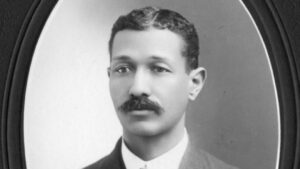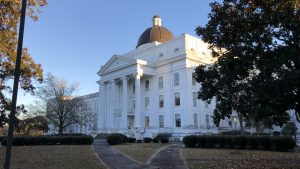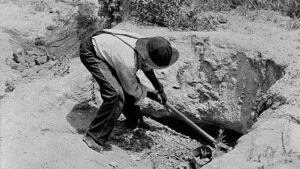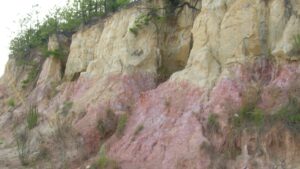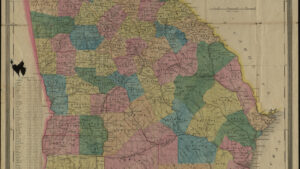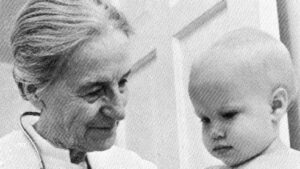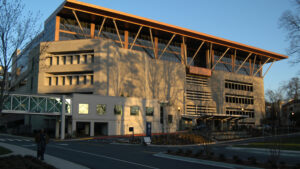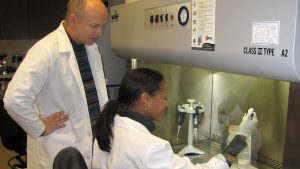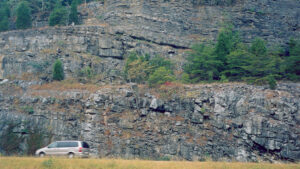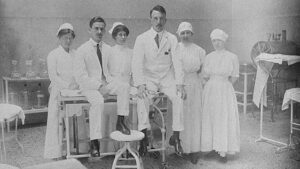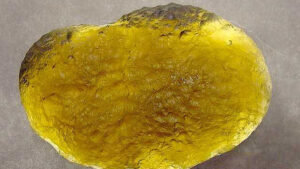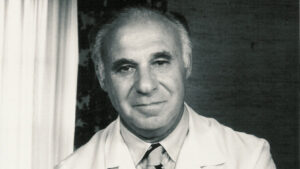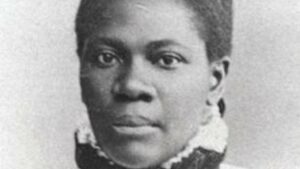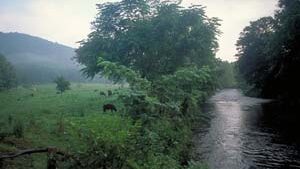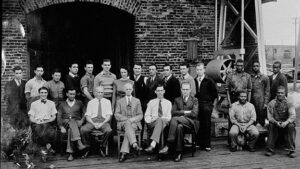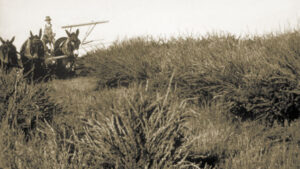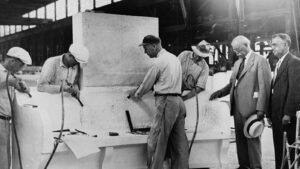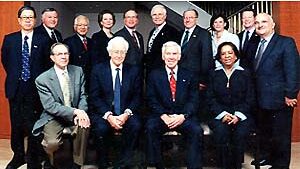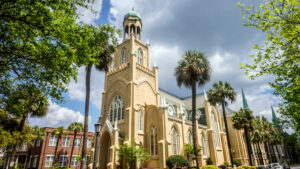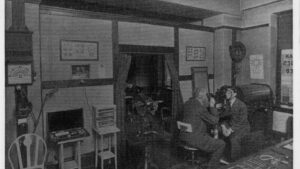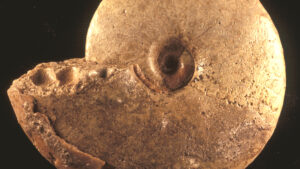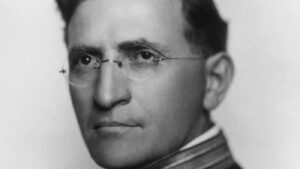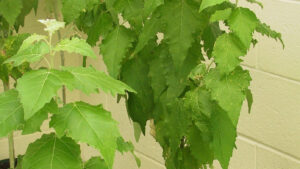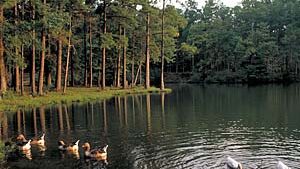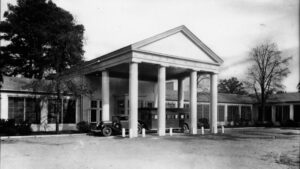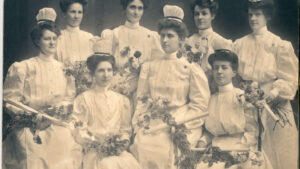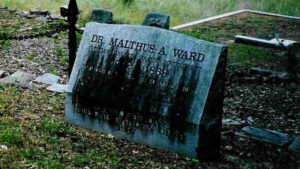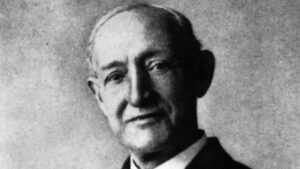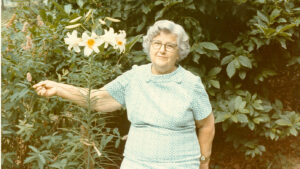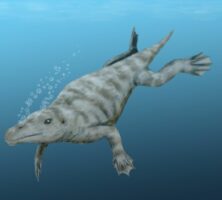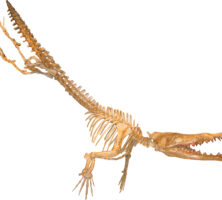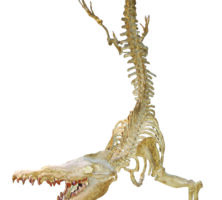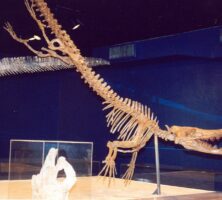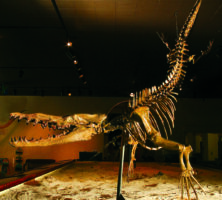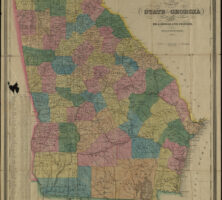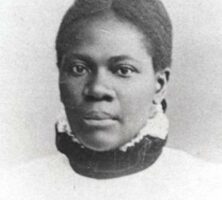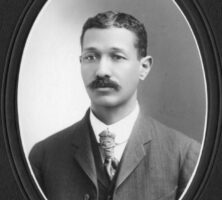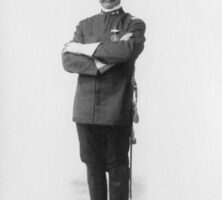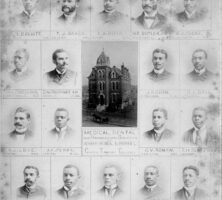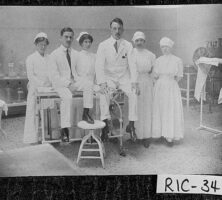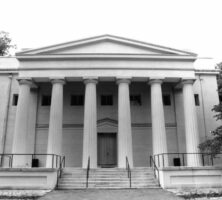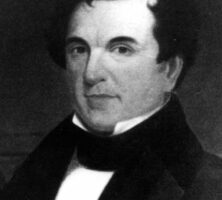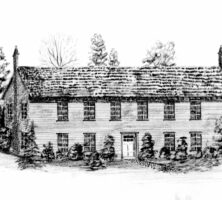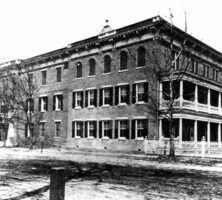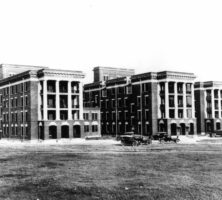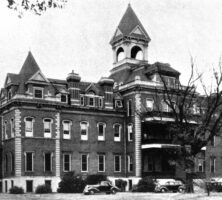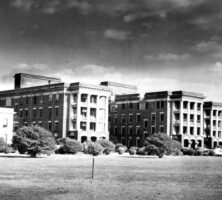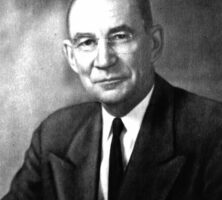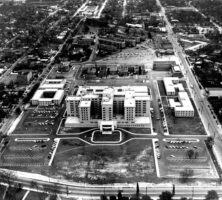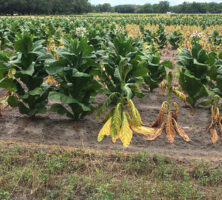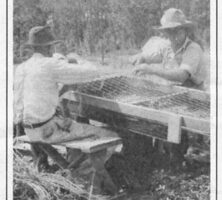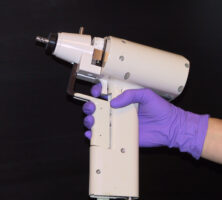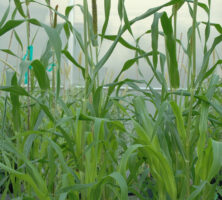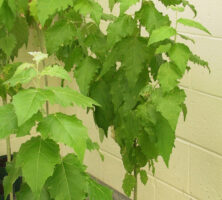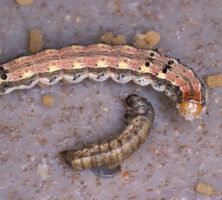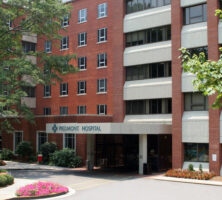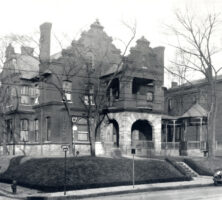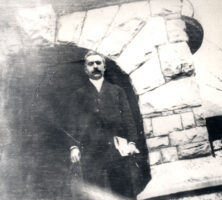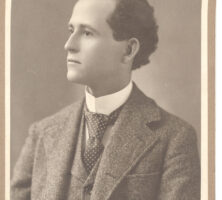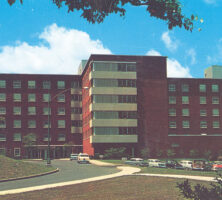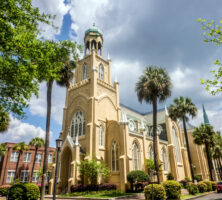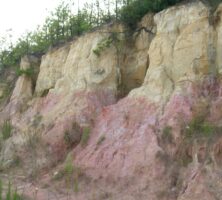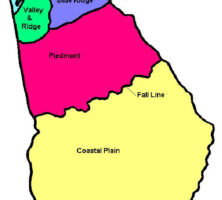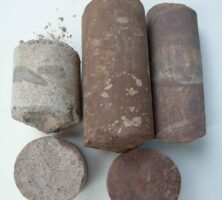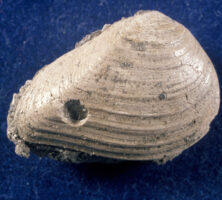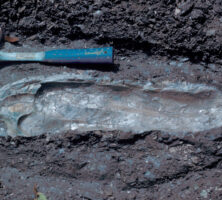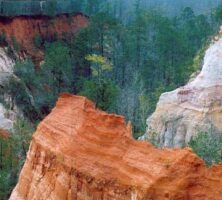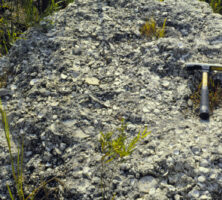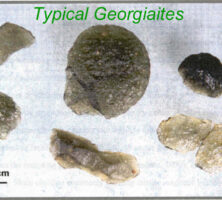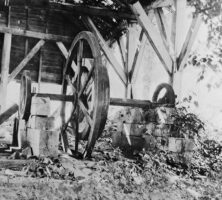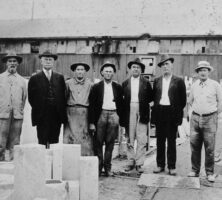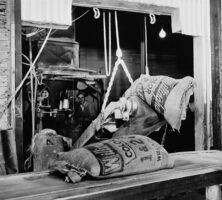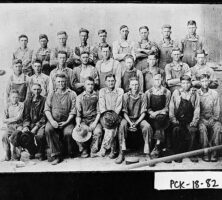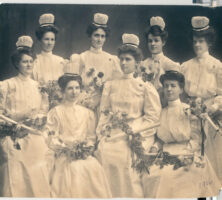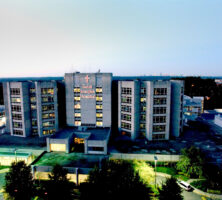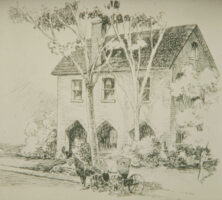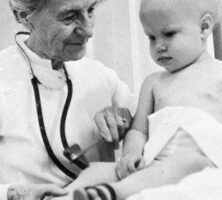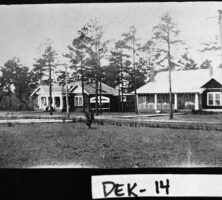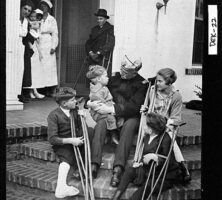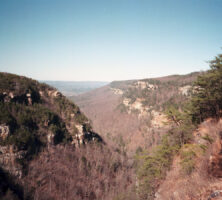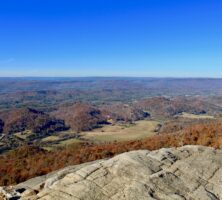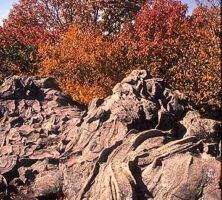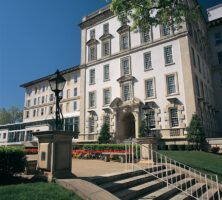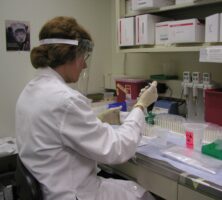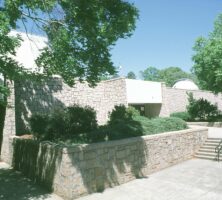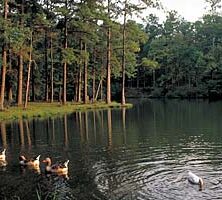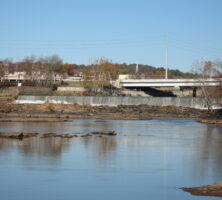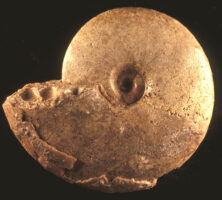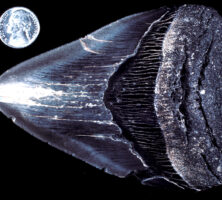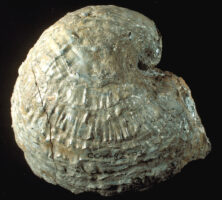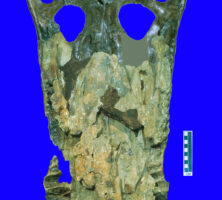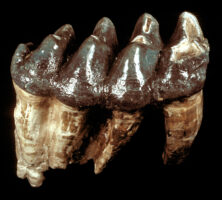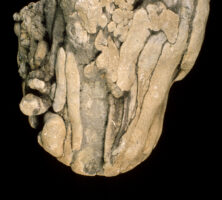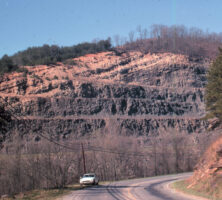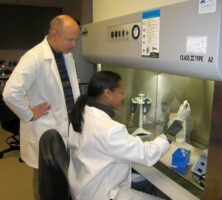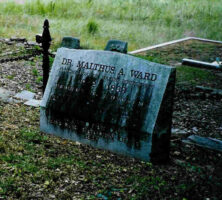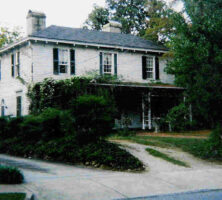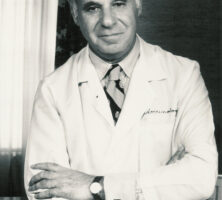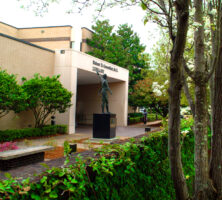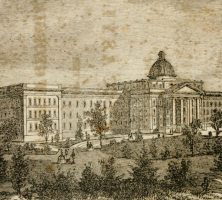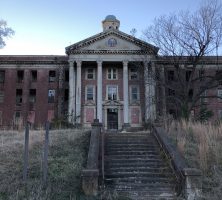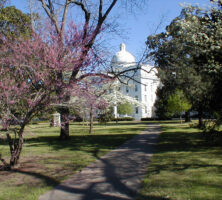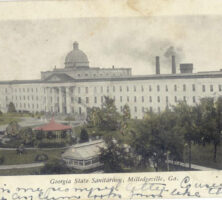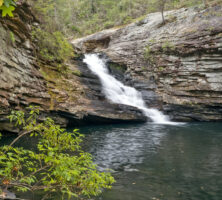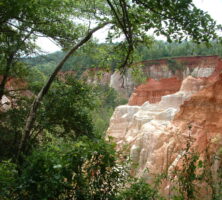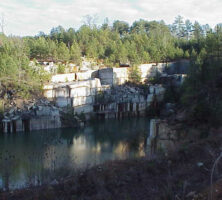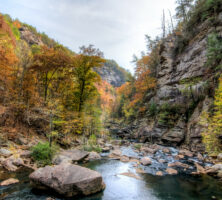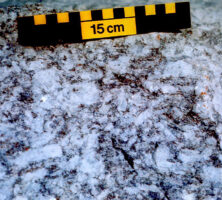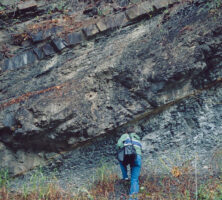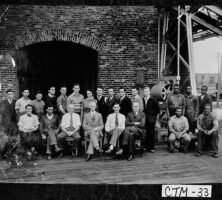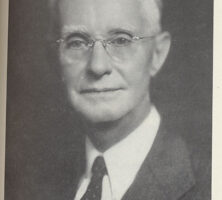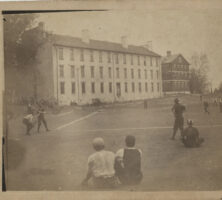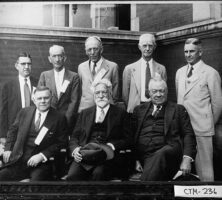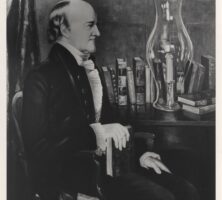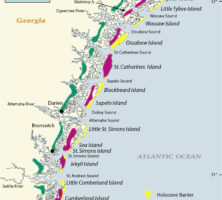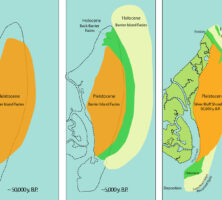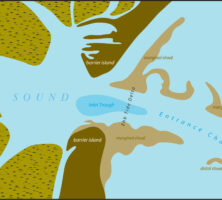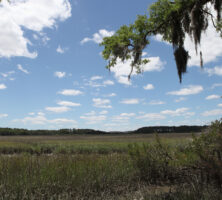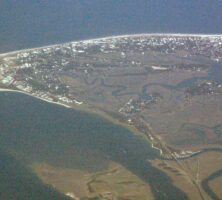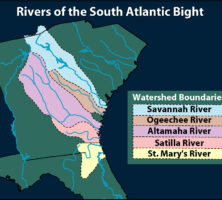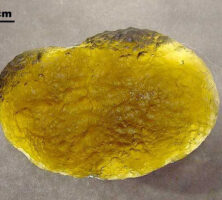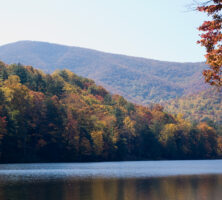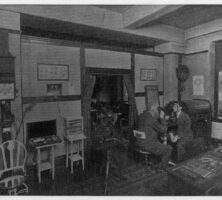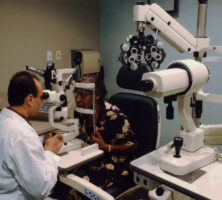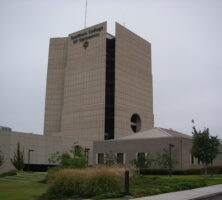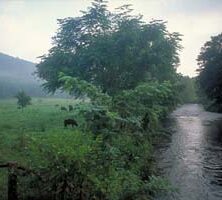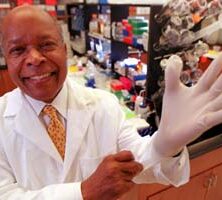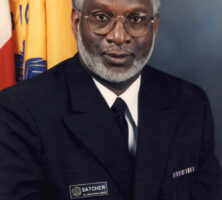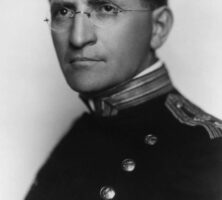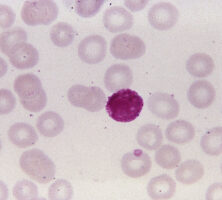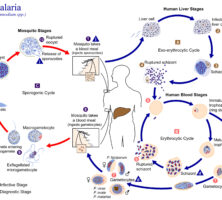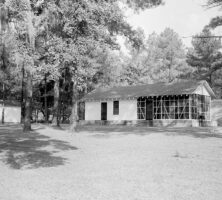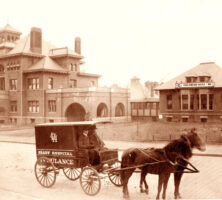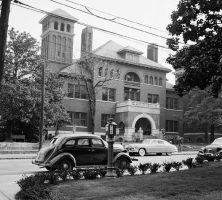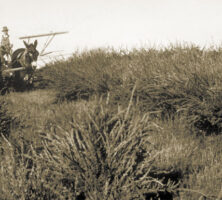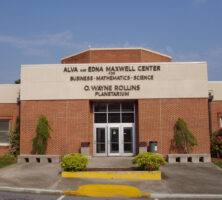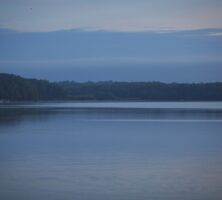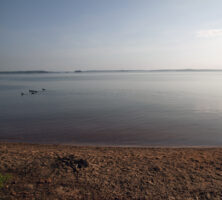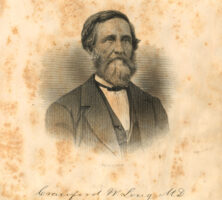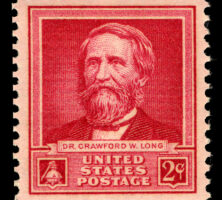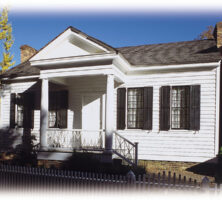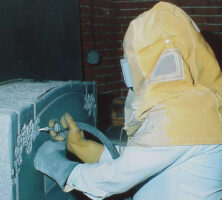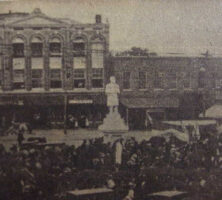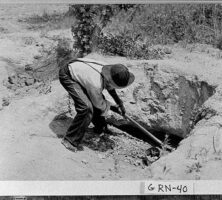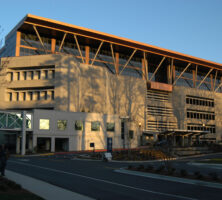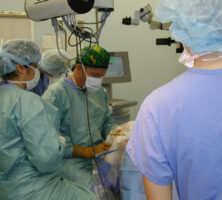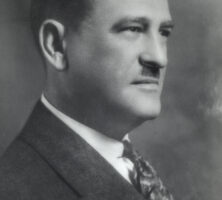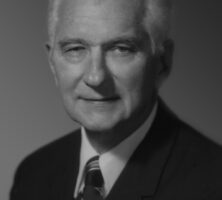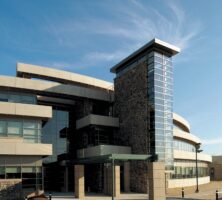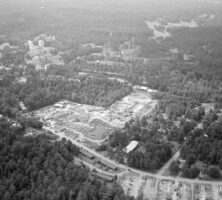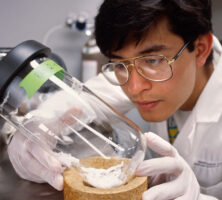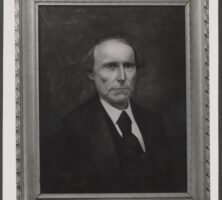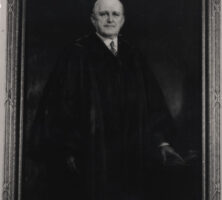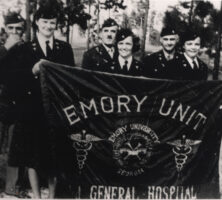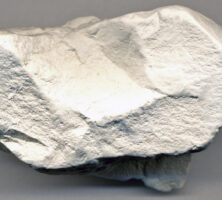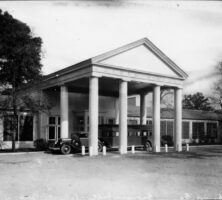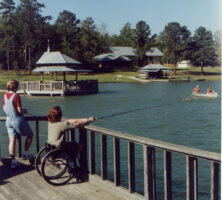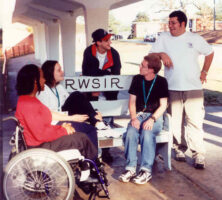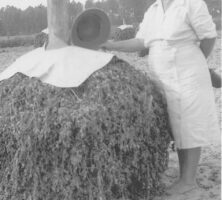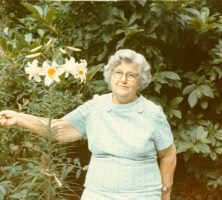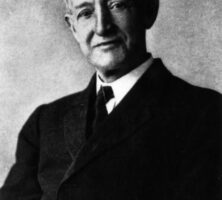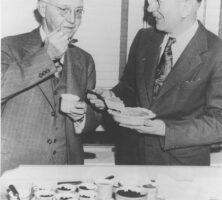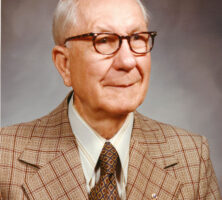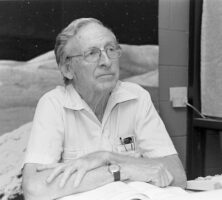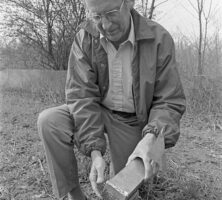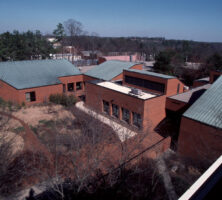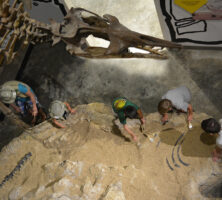The New Georgia Encyclopedia is supported by funding from A More Perfect Union, a special initiative of the National Endowment for the Humanities.
Though scientists long believed that proto-whales may have been amphibious, the discovery of a nearly complete Georgiacetus skeleton by researchers at Georgia Southern University suggests that it was fully marine as depicted in this artist's rendering.
Photograph by Nobu Tamura
The New Georgia Encyclopedia does not hold the copyright for this media resource and can neither grant nor deny permission to republish or reproduce the image online or in print. All requests for permission to publish or reproduce the resource must be submitted to the rights holder.
Three individual Georgiacetus whales were unearthed from 40-million-year-old sediments during the construction of Plant Vogtle. Researchers named the fossils Goergiacetus vogtlensis, meaning "Georgia Whale from Plant Vogtle."
Courtesy of Georgia Southern University Museum
The New Georgia Encyclopedia does not hold the copyright for this media resource and can neither grant nor deny permission to republish or reproduce the image online or in print. All requests for permission to publish or reproduce the resource must be submitted to the rights holder.
The living Georgiacetus whale was estimated to be eleven feet long, based on the skull, which was itself about thirty inches long.
Courtesy Georgia Southern University Museum
The New Georgia Encyclopedia does not hold the copyright for this media resource and can neither grant nor deny permission to republish or reproduce the image online or in print. All requests for permission to publish or reproduce the resource must be submitted to the rights holder.
The Georgiacetus whale, an early ancestor of the modern whale, lived in the shallow sea that covered Georgia during the Eocene epoch (of the Paleogene period). The whale's hind legs and hips were functional.
Photograph by Pamela J. W. Gore
The New Georgia Encyclopedia does not hold the copyright for this media resource and can neither grant nor deny permission to republish or reproduce the image online or in print. All requests for permission to publish or reproduce the resource must be submitted to the rights holder.
A reconstruction of Georgiacetus can be seen at the Georgia Southern University Museum in Statesboro. Georgia Southern researchers discovered and recovered a Georgiacetus skeleton in the mid-1980s.
Courtesy of Georgia Southern University Museum
The New Georgia Encyclopedia does not hold the copyright for this media resource and can neither grant nor deny permission to republish or reproduce the image online or in print. All requests for permission to publish or reproduce the resource must be submitted to the rights holder.
William G. Bonner's Pocket Map of the State of Georgia was published in Milledgeville in 1851. Bonner was a civil engineer who published a series of pocket maps in the mid-nineteenth century.
The New Georgia Encyclopedia does not hold the copyright for this media resource and can neither grant nor deny permission to republish or reproduce the image online or in print. Requests for permission to publish or reproduce the resource should be submitted to the Hargrett Manuscript and Rare Book Library at the University of Georgia.
Eliza Ann Grier was the first African American woman licensed to practice medicine in the state of Georgia. After her graduation in 1897 from the Woman's Medical College in Pennsylvania (later part of Drexel University College of Medicine), she practiced in Atlanta for a few years.
Image from National Library of Medicine
The New Georgia Encyclopedia does not hold the copyright for this media resource and can neither grant nor deny permission to republish or reproduce the image online or in print. All requests for permission to publish or reproduce the resource must be submitted to the rights holder.
Henry Rutherford Butler, pictured circa 1883, was a prominent physician and pharmacist on Atlanta's Sweet Auburn Avenue in the late nineteenth and early twentieth centuries. His wife, Selena Sloan Butler, was a well-known education advocate in the city.
Courtesy of Archives Division, Auburn Avenue Research Library on African American Culture and History, Atlanta-Fulton Public Library System
The New Georgia Encyclopedia does not hold the copyright for this media resource and can neither grant nor deny permission to republish or reproduce the image online or in print. All requests for permission to publish or reproduce the resource must be submitted to the rights holder.
Henry Rutherford Butler, a pioneer in medicine and health care for African Americans, served in 1891 as surgeon of the Second Georgia Battalion, Colored Volunteers, with the rank of first lieutenant. That same year Rutherford began his medical practice on Atlanta's Wheat Street (later Auburn Avenue).
Courtesy of Archives Division, Auburn Avenue Research Library on African American Culture and History, Atlanta-Fulton Public Library System
The New Georgia Encyclopedia does not hold the copyright for this media resource and can neither grant nor deny permission to republish or reproduce the image online or in print. All requests for permission to publish or reproduce the resource must be submitted to the rights holder.
Thomas Heathe Slater (third row, far right) and Henry Rutherford Butler (top row, fourth from left) were classmates together at Meharry Medical College in Nashville, Tennessee. After graduating in 1890, they became the first African Americans to obtain a pharmacy license in Georgia. In 1891 the two opened a drugstore together in Atlanta and operated it for two decades.
Courtesy of Archives Division, Auburn Avenue Research Library on African American Culture and History, Atlanta-Fulton Public Library System
The New Georgia Encyclopedia does not hold the copyright for this media resource and can neither grant nor deny permission to republish or reproduce the image online or in print. All requests for permission to publish or reproduce the resource must be submitted to the rights holder.
Members of the operating room staff at the Medical Department of UGA (later Georgia Health Sciences University) in Augusta are pictured in the early 1900s.
Courtesy of Georgia Archives, Vanishing Georgia, #
ric034.
The New Georgia Encyclopedia does not hold the copyright for this media resource and can neither grant nor deny permission to republish or reproduce the image online or in print. Requests for permission to publish or reproduce the resource should be submitted to the Georgia Archives.
The original building on the campus of Georgia Health Sciences University, completed in Augusta in 1837, was designed by the architect Charles B. Cluskey. The structure, Cluskey's first major building, is an excellent example of the Greek revival style.
Courtesy of Georgia Health Sciences University
The New Georgia Encyclopedia does not hold the copyright for this media resource and can neither grant nor deny permission to republish or reproduce the image online or in print. All requests for permission to publish or reproduce the resource must be submitted to the rights holder.
The New Georgia Encyclopedia does not hold the copyright for this media resource and can neither grant nor deny permission to republish or reproduce the image online or in print. All requests for permission to publish or reproduce the resource must be submitted to the rights holder.
Milton M. Antony, a physician in Augusta, was instrumental in the 1828 founding of the Medical Academy of Georgia, which later became Georgia Health Sciences University.
Courtesy of Historical Collections and Archives, Robert B. Greenblatt, M.D. Library, Georgia Health Sciences University
The New Georgia Encyclopedia does not hold the copyright for this media resource and can neither grant nor deny permission to republish or reproduce the image online or in print. All requests for permission to publish or reproduce the resource must be submitted to the rights holder.
The city hospital in Augusta, built in 1818, served as the first home for Georgia Health Sciences University, from 1828 until the mid-1830s.
Courtesy of Historical Collections and Archives, Robert B. Greenblatt, M.D. Library, Georgia Health Sciences University
The New Georgia Encyclopedia does not hold the copyright for this media resource and can neither grant nor deny permission to republish or reproduce the image online or in print. All requests for permission to publish or reproduce the resource must be submitted to the rights holder.
The New Georgia Encyclopedia does not hold the copyright for this media resource and can neither grant nor deny permission to republish or reproduce the image online or in print. All requests for permission to publish or reproduce the resource must be submitted to the rights holder.
A new city hospital in Augusta, which opened in 1869 and served for many years as the clinical training site for students at the Medical Department of UGA (later Georgia Health Sciences University), is pictured in 1894, following a renovation.
Courtesy of Historical Collections and Archives, Robert B. Greenblatt, M.D. Library, Georgia Health Sciences University
The New Georgia Encyclopedia does not hold the copyright for this media resource and can neither grant nor deny permission to republish or reproduce the image online or in print. All requests for permission to publish or reproduce the resource must be submitted to the rights holder.
University Hospital, completed in Augusta in 1915, was built for the Medical Department of UGA (later Georgia Health Sciences University) with the city's backing.
Courtesy of Historical Collections and Archives, Robert B. Greenblatt, M.D. Library, Georgia Health Sciences University
The New Georgia Encyclopedia does not hold the copyright for this media resource and can neither grant nor deny permission to republish or reproduce the image online or in print. All requests for permission to publish or reproduce the resource must be submitted to the rights holder.
The Newton Building, on the campus of the Medical College of Georgia (later Georgia Health Sciences University) in Augusta, was occupied by the college from 1913 until 1956. The structure was demolished in 1960.
Courtesy of Historical Collections and Archives, Robert B. Greenblatt, M.D. Library, Georgia Health Sciences University
The New Georgia Encyclopedia does not hold the copyright for this media resource and can neither grant nor deny permission to republish or reproduce the image online or in print. All requests for permission to publish or reproduce the resource must be submitted to the rights holder.
University Hospital, part of Georgia Health Sciences University in Augusta, was expanded in the mid-1930s as part of an effort to restore the good rating of the college and its membership in the Association of American Medical Colleges.
Courtesy of Historical Collections and Archives, Robert B. Greenblatt, M.D. Library, Georgia Health Sciences University
The New Georgia Encyclopedia does not hold the copyright for this media resource and can neither grant nor deny permission to republish or reproduce the image online or in print. All requests for permission to publish or reproduce the resource must be submitted to the rights holder.
G. Lombard Kelly served as dean of the Medical College of Georgia (later Georgia Health Sciences University) from 1934 until 1950, and as the college's first president from 1950 to 1953.
Courtesy of Historical Collections and Archives, Robert B. Greenblatt, M.D. Library, Georgia Health Sciences University
The New Georgia Encyclopedia does not hold the copyright for this media resource and can neither grant nor deny permission to republish or reproduce the image online or in print. All requests for permission to publish or reproduce the resource must be submitted to the rights holder.
The Eugene Talmadge Memorial Hospital in Augusta, built by the state for the Medical College of Georgia (later Georgia Health Sciences University), opened in June 1956 with six buildings.
Courtesy of Historical Collections and Archives, Robert B. Greenblatt, M.D. Library, Georgia Health Sciences University
The New Georgia Encyclopedia does not hold the copyright for this media resource and can neither grant nor deny permission to republish or reproduce the image online or in print. All requests for permission to publish or reproduce the resource must be submitted to the rights holder.
Transgenic, or genetically modified, tobacco plants grow in the laboratory of geneticist Richard Meagher at the University of Georgia.
Photograph by Sarah E. McKee, New Georgia Encyclopedia
The New Georgia Encyclopedia does not hold the copyright for this media resource and can neither grant nor deny permission to republish or reproduce the image online or in print. All requests for permission to publish or reproduce the resource must be submitted to the rights holder.
A tobacco farm in south Georgia. While researchers in Georgia have made advances in the field of genetic engineering to develop crops that are resistant to weeds and insects, most genetics research on tobacco in the state examines the plant's impact on public health.
Photograph from CAES Newsire, University of Georgia
The New Georgia Encyclopedia does not hold the copyright for this media resource and can neither grant nor deny permission to republish or reproduce the image online or in print. All requests for permission to publish or reproduce the resource must be submitted to the rights holder.
Georgia is the top producer of peanuts in the United States. Farmers in the state rely on genetics research, conducted at the National Peanut Research Laboratory in Dawson, the University of Georgia Tifton campus, and the Georgia Experiment Station in Griffin, to enhance peanut plants for higher yield and quality.
Courtesy of Special Collections & Archives, Georgia State University Library, Atlanta Journal-Constitution Photographic Archive.
The New Georgia Encyclopedia does not hold the copyright for this media resource and can neither grant nor deny permission to republish or reproduce the image online or in print. Requests for permission to publish or reproduce the resource should be submitted to Special Collections and Archives at Georgia State University.
The New Georgia Encyclopedia does not hold the copyright for this media resource and can neither grant nor deny permission to republish or reproduce the image online or in print. All requests for permission to publish or reproduce the resource must be submitted to the rights holder.
One of the many innovations introduced by Naomi Chapman Woodroof, an early pioneer in peanut research, was the use of bedsprings to separate peanuts from the plant during harvest. Woodroof worked at the Coastal Plain Experiment Station (later University of Georgia Tifton campus) from 1933 to 1967.
Courtesy of Jane Woodroof Akers
The New Georgia Encyclopedia does not hold the copyright for this media resource and can neither grant nor deny permission to republish or reproduce the image online or in print. All requests for permission to publish or reproduce the resource must be submitted to the rights holder.
Transgenic arabidopsis plants grow in the laboratory of geneticist Richard Meagher at the University of Georgia. Arabidopsis plants are commonly used in genetic engineering research because they grow and produce seeds quickly, allowing researchers to produce many generations in a relatively short period of time.
Photograph by Sarah E. McKee, New Georgia Encyclopedia
The New Georgia Encyclopedia does not hold the copyright for this media resource and can neither grant nor deny permission to republish or reproduce the image online or in print. All requests for permission to publish or reproduce the resource must be submitted to the rights holder.
A gene gun shoots small gold particles coated with selected genes from one organism into the plasma membrane of a target organism. The genes contain information for desirable traits, such as disease resistance, that researchers hope will be expressed by the target organism.
Photograph by Sarah E. McKee, New Georgia Encyclopedia
The New Georgia Encyclopedia does not hold the copyright for this media resource and can neither grant nor deny permission to republish or reproduce the image online or in print. All requests for permission to publish or reproduce the resource must be submitted to the rights holder.
Arabidopsis seedlings genetically engineered to resist toxic heavy metals grow on the right side of a petri dish in Richard Meagher's genetics laboratory at the University of Georgia. (Wild-type plants grow on the left.) Plants resistant to heavy metals and other toxins are used to clean the environment in a process known as phytoremediation.
Photograph by Melissa Pischke LeBlanc
The New Georgia Encyclopedia does not hold the copyright for this media resource and can neither grant nor deny permission to republish or reproduce the image online or in print. All requests for permission to publish or reproduce the resource must be submitted to the rights holder.
Genetically engineered, or transgenic, pearl millet plants grow in the lab of Peggy Ozais-Akins at the Coastal Plain Experiment Station (later University of Georgia Tifton campus) in Tifton. Ozais-Akins developed a system to make a transgenic pearl millet cell that can be genetically modified quickly and then coaxed to grow into a fertile plant.
Courtesy of Peggy Ozais-Akins
The New Georgia Encyclopedia does not hold the copyright for this media resource and can neither grant nor deny permission to republish or reproduce the image online or in print. All requests for permission to publish or reproduce the resource must be submitted to the rights holder.
Transgenic (genetically modified) yellow poplar trees grow in the laboratory of geneticist Richard Meagher at the University of Georgia. Researchers at UGA engineered a strain of yellow poplar capable of growing in soil contaminated with mercury and converting the metal into a less harmful form. The process of using plants to remove toxins from the environment is called phytoremediation.
Photograph by Sarah E. McKee, New Georgia Encyclopedia
The New Georgia Encyclopedia does not hold the copyright for this media resource and can neither grant nor deny permission to republish or reproduce the image online or in print. All requests for permission to publish or reproduce the resource must be submitted to the rights holder.
Cotton plays a significant role in the state's economy. In order to increase crop yield and minimize dangerous pesticide use, many Georgia farmers grow cotton plants that are genetically modified to resist insects and specific herbicides. By 2004 such transgenic cotton accounted for 95 percent of Georgia's total crop.
Courtesy of Agricultural Research Service, U.S. Department of Agriculture
The New Georgia Encyclopedia does not hold the copyright for this media resource and can neither grant nor deny permission to republish or reproduce the image online or in print. All requests for permission to publish or reproduce the resource must be submitted to the rights holder.
Budworms are pest insects that cause significant problems for cotton farmers in Georgia. Through advances in genetic engineering, scientists have developed a cotton plant resistant to budworms and other pests, including bollworms and spider mites.
Courtesy of Agricultural Research Service, U.S. Department of Agriculture
The New Georgia Encyclopedia does not hold the copyright for this media resource and can neither grant nor deny permission to republish or reproduce the image online or in print. All requests for permission to publish or reproduce the resource must be submitted to the rights holder.
Piedmont Hospital, located in the Buckhead community of Atlanta, is a private, not-for-profit institution founded in 1905. An acute tertiary-care facility, Piedmont Hospital is the flagship institution of Piedmont Healthcare.
Courtesy of Piedmont Hospital Archives
The New Georgia Encyclopedia does not hold the copyright for this media resource and can neither grant nor deny permission to republish or reproduce the image online or in print. All requests for permission to publish or reproduce the resource must be submitted to the rights holder.
The first facility for Piedmont Hospital, pictured circa 1915, was a fifteen-room home located at the corner of Capitol Avenue and Crumley Street in downtown Atlanta. The hospital, founded in 1905 as Piedmont Sanatorium, remained in this location until 1957.
Courtesy of Piedmont Hospital Archives
The New Georgia Encyclopedia does not hold the copyright for this media resource and can neither grant nor deny permission to republish or reproduce the image online or in print. All requests for permission to publish or reproduce the resource must be submitted to the rights holder.
Dr. Ludwig Amster, a specialist in gastrointestinal diseases, stands outside the Piedmont Sanatorium circa 1920. Amster founded the facility, known today as Piedmont Hospital, in 1905 with surgeon Dr. Floyd W. McRae Sr.
Courtesy of Piedmont Hospital Archives
The New Georgia Encyclopedia does not hold the copyright for this media resource and can neither grant nor deny permission to republish or reproduce the image online or in print. All requests for permission to publish or reproduce the resource must be submitted to the rights holder.
Dr. Floyd W. McRae Sr., pictured in 1895, was a surgeon and the cofounder of Piedmont Sanatorium (later Piedmont Hospital), which opened in 1905 in downtown Atlanta.
Photograph from C. W. Motes, in Piedmont Hospital Archives
The New Georgia Encyclopedia does not hold the copyright for this media resource and can neither grant nor deny permission to republish or reproduce the image online or in print. All requests for permission to publish or reproduce the resource must be submitted to the rights holder.
In 1957 Piedmont Hosptial, pictured circa 1960, moved from downtown Atlanta to the Buckhead community of Atlanta. At that time the facility had 250 beds and a staff of 127 physicians.
Courtesy of Piedmont Hospital Archives
The New Georgia Encyclopedia does not hold the copyright for this media resource and can neither grant nor deny permission to republish or reproduce the image online or in print. All requests for permission to publish or reproduce the resource must be submitted to the rights holder.
Congregation Mickve Israel in Savannah is the oldest Jewish congregation in the South and the third oldest in the United States. The congregation was founded during the establishment of the colony in 1733, and the current temple building was completed in 1878.
Photograph by Mark Kortum
The New Georgia Encyclopedia does not hold the copyright for this media resource and can neither grant nor deny permission to republish or reproduce the image online or in print. All requests for permission to publish or reproduce the resource must be submitted to the rights holder.
Strata of nonmarine sediments are pictured just across the state line in Phenix City, Alabama. Alternating layers of marine and nonmarine rock formations in the Coastal Plain reveal that long-term fluctuations in sea level occurred in Georgia throughout the Late Cretaceous period.
Photograph by Pamela J. W. Gore
The New Georgia Encyclopedia does not hold the copyright for this media resource and can neither grant nor deny permission to republish or reproduce the image online or in print. All requests for permission to publish or reproduce the resource must be submitted to the rights holder.
One end of Georgia's fall line, which marks the boundary between the hard rocks of the Piedmont geologic province and the softer rocks of the Coastal Plain, is located in Columbus. Marked by waterfalls and rapids, the fall line stretches across the state to Augusta.
Photograph by Pamela J. W. Gore
The New Georgia Encyclopedia does not hold the copyright for this media resource and can neither grant nor deny permission to republish or reproduce the image online or in print. All requests for permission to publish or reproduce the resource must be submitted to the rights holder.
High Falls is located along the fall line at High Falls State Park in Butts County. The fall line crosses the state from Augusta to Columbus and marks the point at which the hard rocks of the Piedmont meet the softer rocks of the Coastal Plain.
Image from Stephen Rahn
The New Georgia Encyclopedia does not hold the copyright for this media resource and can neither grant nor deny permission to republish or reproduce the image online or in print. All requests for permission to publish or reproduce the resource must be submitted to the rights holder.
Georgia encompasses parts of five distinct geographic regions: the Appalachian Plateau, the Valley and Ridge, the Blue Ridge, the Piedmont, and the Coastal Plain.
Courtesy of Pamela J. W. Gore
The New Georgia Encyclopedia does not hold the copyright for this media resource and can neither grant nor deny permission to republish or reproduce the image online or in print. All requests for permission to publish or reproduce the resource must be submitted to the rights holder.
Rock cores dating from the Triassic Period represent the oldest geologic layer in Georgia, which is composed of red sandstones, conglomerates, shales, and other nonmarine sediments. Triassic-age rocks are not visible at the surface in Georgia and were detected through seismic profiling and deep drilling.
Photograph by Pamela J. W. Gore
The New Georgia Encyclopedia does not hold the copyright for this media resource and can neither grant nor deny permission to republish or reproduce the image online or in print. All requests for permission to publish or reproduce the resource must be submitted to the rights holder.
This fossil of a Late Cretaceous clam, Crassatellites roodensis, features a hole bored by a type of snail known as a naticid. Such holes were a cause of mortality for many clam species during this period.
Photograph by David R. Schwimmer
The New Georgia Encyclopedia does not hold the copyright for this media resource and can neither grant nor deny permission to republish or reproduce the image online or in print. All requests for permission to publish or reproduce the resource must be submitted to the rights holder.
The Late Cretaceous oyster, Crassostrea cusseta, pictured alongside a hammer measuring 33 centimeters in length, could grow to 60 centimeters. This specimen was found at the Blufftown Formation in Stewart County.
Photograph by David R. Schwimmer
The New Georgia Encyclopedia does not hold the copyright for this media resource and can neither grant nor deny permission to republish or reproduce the image online or in print. All requests for permission to publish or reproduce the resource must be submitted to the rights holder.
Providence Canyon, in Stewart County, reveals the white Providence Sand, which dates to the Late Cretaceous period, lying beneath the reddish Clayton Formation, which formed during the Paleogene period.
Photograph by Pamela J. W. Gore
The New Georgia Encyclopedia does not hold the copyright for this media resource and can neither grant nor deny permission to republish or reproduce the image online or in print. All requests for permission to publish or reproduce the resource must be submitted to the rights holder.
The New Georgia Encyclopedia does not hold the copyright for this media resource and can neither grant nor deny permission to republish or reproduce the image online or in print. All requests for permission to publish or reproduce the resource must be submitted to the rights holder.
Pictured near Perry, in Houston County, the Tivola Limestone formed during the Late Eocene epoch, when sea levels in the region were particularly high. The Tivola is considered to be an extension of the Ocala Limestone, a white, fossiliferous limestone that formed during the Late Eocene in the Dougherty Plain of southwest Georgia.
Photograph by Pamela J. W. Gore
The New Georgia Encyclopedia does not hold the copyright for this media resource and can neither grant nor deny permission to republish or reproduce the image online or in print. All requests for permission to publish or reproduce the resource must be submitted to the rights holder.
The New Georgia Encyclopedia does not hold the copyright for this media resource and can neither grant nor deny permission to republish or reproduce the image online or in print. All requests for permission to publish or reproduce the resource must be submitted to the rights holder.
Georgiaites, or tektites, are natural glasses formed when an asteroid or meteorite collides with the earth. Many scientists believe that georgiaites formed as a result of the meteorite impact that created the Chesapeake Bay Crater in Virginia around 35 million years ago.
Photograph by Edward Albin
The New Georgia Encyclopedia does not hold the copyright for this media resource and can neither grant nor deny permission to republish or reproduce the image online or in print. All requests for permission to publish or reproduce the resource must be submitted to the rights holder.
The state capitol building, completed in 1889, features a cornerstone, interior floor and steps, and many walls made of Georgia marble. Marble mined in the state was also used to construct 60 percent of the monuments and the U.S. Capitol in Washington, D.C.
Courtesy of Explore Georgia, Photograph by Ralph Daniel.
The New Georgia Encyclopedia does not hold the copyright for this media resource and can neither grant nor deny permission to republish or reproduce the image online or in print. Requests for permission to publish or reproduce the resource may need to be submitted to Explore Georgia.
A gang saw at the first plant built by the Georgia Marble Company in Pickens County is pictured circa 1885. The company was founded in 1884 by Samuel Tate, who in the 1830s purchased large tracts of land containing marble in north Georgia.
Courtesy of Georgia Archives, Vanishing Georgia, # pck285-85.
The New Georgia Encyclopedia does not hold the copyright for this media resource and can neither grant nor deny permission to republish or reproduce the image online or in print. Requests for permission to publish or reproduce the resource should be submitted to the Georgia Archives.
Colonel Sam Tate (second from left), the grandson of Georgia Marble Company founder Samuel Tate, poses with a group of foremen at the Pickens County plant, circa 1925. Colonel Sam served as president of the company from 1905 until his death in 1938.
Courtesy of Georgia Archives, Vanishing Georgia, # pck111-82.
The New Georgia Encyclopedia does not hold the copyright for this media resource and can neither grant nor deny permission to republish or reproduce the image online or in print. Requests for permission to publish or reproduce the resource should be submitted to the Georgia Archives.
Colonel Sam Tate, the president of the Georgia Marble Company, oversees the production of a marble bench in the Pickens County plant, circa 1930. The marble industry in the state prospered during the early 1930s but suffered losses from 1933 through the rest of the decade.
Courtesy of Georgia Archives, Vanishing Georgia, # pck250-85.
The New Georgia Encyclopedia does not hold the copyright for this media resource and can neither grant nor deny permission to republish or reproduce the image online or in print. Requests for permission to publish or reproduce the resource should be submitted to the Georgia Archives.
Sacks of ground or pulverized marble are produced at the Calcium Products Division of the Georgia Marble Company in Tate (Pickens County), circa 1950. The division was created in 1947 to sell "waste" marble, which is used as filler in paints and plastics. Ground marble products became the company's main product by the late 1980s.
Courtesy of Georgia Archives, Vanishing Georgia, #pck253-85.
The New Georgia Encyclopedia does not hold the copyright for this media resource and can neither grant nor deny permission to republish or reproduce the image online or in print. Requests for permission to publish or reproduce the resource should be submitted to the Georgia Archives.
Marble slabs used to make columns during reconstruction work on the U.S. Capitol in Washington, D.C., are cut at the Georgia Marble Company in Pickens County, circa 1958.
Courtesy of Georgia Archives, Vanishing Georgia, # pck043-82.
The New Georgia Encyclopedia does not hold the copyright for this media resource and can neither grant nor deny permission to republish or reproduce the image online or in print. Requests for permission to publish or reproduce the resource should be submitted to the Georgia Archives.
Workers for the Georgia Marble Company sit for a portrait during the 1920s at the Marblehill Quarry in Pickens County. Marble from Pickens County is reported to have been used in around 60 percent of the monuments in Washington, D.C.
Courtesy of Georgia Archives, Vanishing Georgia, #
pck018-82.
The New Georgia Encyclopedia does not hold the copyright for this media resource and can neither grant nor deny permission to republish or reproduce the image online or in print. Requests for permission to publish or reproduce the resource should be submitted to the Georgia Archives.
Graduates of Saint Joseph's Nursing School in Atlanta pose in 1906. The nursing school opened in 1900 and operated until 1973, graduating a total of more than 1,300 nurses.
Courtesy of Saint Joseph's Hospital
The New Georgia Encyclopedia does not hold the copyright for this media resource and can neither grant nor deny permission to republish or reproduce the image online or in print. All requests for permission to publish or reproduce the resource must be submitted to the rights holder.
Saint Joseph's Hospital, located on a thirty-two-acre campus in north Atlanta since 1973, is the oldest medical facility in Atlanta. Founded by Catholic nuns in 1880, Saint Joseph's is nationally recognized for excellence in both patient care and research.
Courtesy of Saint Joseph's Hospital
The New Georgia Encyclopedia does not hold the copyright for this media resource and can neither grant nor deny permission to republish or reproduce the image online or in print. All requests for permission to publish or reproduce the resource must be submitted to the rights holder.
Saint Joseph's Hospital in Atlanta has been a forerunner in the Southeast for developing surgical procedures, from performing the region's first open-heart surgery in 1957 to utilizing minimally invasive robotic surgery in the twenty-first century.
Courtesy of Saint Joseph's Hospital
The New Georgia Encyclopedia does not hold the copyright for this media resource and can neither grant nor deny permission to republish or reproduce the image online or in print. All requests for permission to publish or reproduce the resource must be submitted to the rights holder.
Saint Joseph's Hospital, originally known as Atlanta Hospital, first opened in a home on Baker Street in Atlanta. The facility later moved to a building on Courtland Street before dedicating its current location in north Atlanta in 1973.
Courtesy of Saint Joseph's Hospital
The New Georgia Encyclopedia does not hold the copyright for this media resource and can neither grant nor deny permission to republish or reproduce the image online or in print. All requests for permission to publish or reproduce the resource must be submitted to the rights holder.
As part of its original mission to offer medical care to the poor, Saint Joseph's Hospital in Atlanta operates the Mercy Care Services program, which includes two health clinics and eight mobile satellite locations as of 2007.
Courtesy of Saint Joseph's Hospital
The New Georgia Encyclopedia does not hold the copyright for this media resource and can neither grant nor deny permission to republish or reproduce the image online or in print. All requests for permission to publish or reproduce the resource must be submitted to the rights holder.
Leila Denmark, a pediatrician in Alpharetta, examines a patient. Denmark opened her practice in 1931 and retired in 2001, at the age of 103, as the oldest practicing pediatrician in the nation. In addition to running her private practice, Denmark conducted research that led to the development of the pertussis (or whooping cough) vaccine.
Courtesy of Jack Tarver Library Special Collections, Mercer University
The New Georgia Encyclopedia does not hold the copyright for this media resource and can neither grant nor deny permission to republish or reproduce the image online or in print. All requests for permission to publish or reproduce the resource must be submitted to the rights holder.
Children's Healthcare of Atlanta was formed in 1998 by the merger of Egleston Children's Health Care System and the Scottish Rite Children's Medical Center. A not-for-profit pediatric hospital, Children's served approximately 493,000 patients in 2005.
Courtesy of Children's Healthcare of Atlanta
The New Georgia Encyclopedia does not hold the copyright for this media resource and can neither grant nor deny permission to republish or reproduce the image online or in print. All requests for permission to publish or reproduce the resource must be submitted to the rights holder.
The Scottish Rite Convalescent Home for Crippled Children, pictured circa 1916, consisted of two wood-frame cottages. The facility opened in Decatur in 1915 and provided post-surgical care to indigent children.
Courtesy of Georgia Archives, Vanishing Georgia, #
dek014.
The New Georgia Encyclopedia does not hold the copyright for this media resource and can neither grant nor deny permission to republish or reproduce the image online or in print. Requests for permission to publish or reproduce the resource should be submitted to the Georgia Archives.
In 2003 Dante Priebe (right) underwent a successful liver-transplant operation, performed by Dr. Thomas Heffron (left) at Children's Healthcare of Atlanta.
Courtesy of Children's Healthcare of Atlanta
The New Georgia Encyclopedia does not hold the copyright for this media resource and can neither grant nor deny permission to republish or reproduce the image online or in print. All requests for permission to publish or reproduce the resource must be submitted to the rights holder.
Patients at the Scottish Rite Hospital for Crippled Children in Decatur are pictured circa 1920. Founded in 1915, the Scottish Rite Hospital merged with the Henrietta Egleston Hospital for Children in 1998 to form Children's Healthcare of Atlanta.
Courtesy of Georgia Archives, Vanishing Georgia, #
dek022.
The New Georgia Encyclopedia does not hold the copyright for this media resource and can neither grant nor deny permission to republish or reproduce the image online or in print. Requests for permission to publish or reproduce the resource should be submitted to the Georgia Archives.
Exposed layers of sandstone are visible in the walls of Cloudland Canyon, part of the Appalachain Plateau geologic province in the northwest corner of Georgia. The vegetated slopes below the sandstone contain gray shale with interbedded sandstone, siderite, and coal.
Photograph by Pamela J. W. Gore
The New Georgia Encyclopedia does not hold the copyright for this media resource and can neither grant nor deny permission to republish or reproduce the image online or in print. All requests for permission to publish or reproduce the resource must be submitted to the rights holder.
Lookout Mountain, located in Dade County, is part of the Appalachian Plateau geologic province. Georgia shares the mountain with Alabama and Tennessee.
Image from Andy Montgomery
The New Georgia Encyclopedia does not hold the copyright for this media resource and can neither grant nor deny permission to republish or reproduce the image online or in print. All requests for permission to publish or reproduce the resource must be submitted to the rights holder.
The New Georgia Encyclopedia does not hold the copyright for this media resource and can neither grant nor deny permission to republish or reproduce the image online or in print. All requests for permission to publish or reproduce the resource must be submitted to the rights holder.
The New Georgia Encyclopedia does not hold the copyright for this media resource and can neither grant nor deny permission to republish or reproduce the image online or in print. All requests for permission to publish or reproduce the resource must be submitted to the rights holder.
Rock Town, located on Pigeon Mountain in Walker County, is a natural rock formation composed of sandstone layers interbedded with shales. Pigeon Mountain is part of the Appalachian Plateau geologic province.
Courtesy of Georgia Department of Economic Development.
The New Georgia Encyclopedia does not hold the copyright for this media resource and can neither grant nor deny permission to republish or reproduce the image online or in print. Requests for permission to publish or reproduce the resource may need to be submitted to the Georgia Department of Economic Development.
Emory University Hospital, located on the campus of Emory University in Atlanta, is a tertiary care facility. Staffed by 1500 physicians, the facility has been the site of several important milestones in the medical history of Georgia, including the performance of the state's first heart, kidney, and lung transplants.
Courtesy of Emory University Hospital
The New Georgia Encyclopedia does not hold the copyright for this media resource and can neither grant nor deny permission to republish or reproduce the image online or in print. All requests for permission to publish or reproduce the resource must be submitted to the rights holder.
A class of graduating nurses poses outside Wesley Memorial Hospital in Atlanta, later Emory University Hospital, in 1916. Wesley Memorial, chartered in 1904, was located in a mansion on Courtland Street until 1922, when the hospital moved to the Emory University campus in DeKalb County.
Courtesy of Georgia Archives, Vanishing Georgia, #
ful0408.
The New Georgia Encyclopedia does not hold the copyright for this media resource and can neither grant nor deny permission to republish or reproduce the image online or in print. Requests for permission to publish or reproduce the resource should be submitted to the Georgia Archives.
Students in the Out of School Girls Project, instituted by CARE in 2003, attend school in Afghanistan. CARE, an Atlanta-based humanitarian organization, focuses on the education of women as one means toward fulfilling its mission of eradicating global poverty.
Courtesy of CARE, Photograph by Phil Borges.
The New Georgia Encyclopedia does not hold the copyright for this media resource and can neither grant nor deny permission to republish or reproduce the image online or in print. All requests for permission to publish or reproduce the resource must be submitted to the rights holder.
Clara Chinyama, with her daughter Alinafe, poses at the construction site of her new tea shop in Malawi. The shop is funded through a savings and loan program provided by CARE, an Atlanta-based organization that works with women around the world to overcome poverty, disease, and environmental problems.
Courtesy of CARE, Photograph by Valenda Campbell.
The New Georgia Encyclopedia does not hold the copyright for this media resource and can neither grant nor deny permission to republish or reproduce the image online or in print. All requests for permission to publish or reproduce the resource must be submitted to the rights holder.
Rhesus macaques are among the seven species of nonhuman primates studied at the Yerkes National Primate Research Center, based in Atlanta at Emory University. These macaques are pictured at the center's field station in Lawrenceville.
Courtesy of Yerkes National Primate Research Center
The New Georgia Encyclopedia does not hold the copyright for this media resource and can neither grant nor deny permission to republish or reproduce the image online or in print. All requests for permission to publish or reproduce the resource must be submitted to the rights holder.
The main center of the Yerkes National Primate Research Center comprises the Neuroscience Building (left), the original building (center), and the Emory Vaccine Center (right). Emory University assumed ownership of the center in 1956.
Courtesy of Yerkes National Primate Research Center
The New Georgia Encyclopedia does not hold the copyright for this media resource and can neither grant nor deny permission to republish or reproduce the image online or in print. All requests for permission to publish or reproduce the resource must be submitted to the rights holder.
Robert Mearns Yerkes, pictured in Orange Park, Florida, founded the Yale Laboratories of Primate Biology in New Haven, Connecticut, in 1928. A year later the facility moved to Orange Park, where it remained until Yerkes's death in 1956. The center was renamed in his honor and relocated to Emory University in Atlanta that same year.
Courtesy of Yerkes National Primate Research Center
The New Georgia Encyclopedia does not hold the copyright for this media resource and can neither grant nor deny permission to republish or reproduce the image online or in print. All requests for permission to publish or reproduce the resource must be submitted to the rights holder.
A researcher at the Yerkes National Primate Research Center, based at Emory University in Atlanta, works in the Biomarkers Core laboratory. The biomedical research conducted at the center helps to provide treatment and prevention strategies for human illnesses.
Courtesy of Yerkes National Primate Research Center
The New Georgia Encyclopedia does not hold the copyright for this media resource and can neither grant nor deny permission to republish or reproduce the image online or in print. All requests for permission to publish or reproduce the resource must be submitted to the rights holder.
Arthritis Today, a bimonthly magazine produced by the Arthritis Foundation, provides information and support to arthritis patients around the country. Established in 1948 and based in Atlanta, the Arthritis Foundation is the largest voluntary health organization in the United States.
Photograph by Daniel Mayer
The New Georgia Encyclopedia does not hold the copyright for this media resource and can neither grant nor deny permission to republish or reproduce the image online or in print. All requests for permission to publish or reproduce the resource must be submitted to the rights holder.
The Fernbank Science Center in Atlanta offers a variety of science education programs to the public in its planetarium, observatory, and exhibit hall. The center also offers tours through the Fernbank Forest, a sixty-five acre primeval forest adjoining the center's grounds.
Courtesy of Fernbank Science Center
The New Georgia Encyclopedia does not hold the copyright for this media resource and can neither grant nor deny permission to republish or reproduce the image online or in print. All requests for permission to publish or reproduce the resource must be submitted to the rights holder.
One of the few stands of original oak and hickory forests remaining in Georgia is located at Fernbank Forest in Atlanta. Trail guides at the Fernbank Science Center offer programs in the forest for both students and the general public throughout the year.
Courtesy of Fernbank Science Center
The New Georgia Encyclopedia does not hold the copyright for this media resource and can neither grant nor deny permission to republish or reproduce the image online or in print. All requests for permission to publish or reproduce the resource must be submitted to the rights holder.
The Jim Cherry Memorial Planetarium at the Fernbank Science Center in Atlanta houses more than 200 projectors, including the Carl Zeiss Mark V projector, which are used to simulate the night sky for students and visitors.
Image from Ryan Stavely
The New Georgia Encyclopedia does not hold the copyright for this media resource and can neither grant nor deny permission to republish or reproduce the image online or in print. All requests for permission to publish or reproduce the resource must be submitted to the rights holder.
Pine Mountain, located in Harris County, is part of the Piedmont geologic province. Located between the Blue Ridge Mountains and the Coastal Plain, the Piedmont forms the foothills of the Appalachian Mountains, which formed during the Paleozoic era.
Courtesy of Georgia Department of Economic Development.
The New Georgia Encyclopedia does not hold the copyright for this media resource and can neither grant nor deny permission to republish or reproduce the image online or in print. Requests for permission to publish or reproduce the resource may need to be submitted to the Georgia Department of Economic Development.
The New Georgia Encyclopedia does not hold the copyright for this media resource and can neither grant nor deny permission to republish or reproduce the image online or in print. All requests for permission to publish or reproduce the resource must be submitted to the rights holder.
The Chattahoochee River flows through Columbus, one of the cities located along the fall line marking the boundary between the Piedmont and Coastal Plain geologic provinces. The hard rocks of the Piedmont form outcrops that create rapids and waterfalls along the fall line.
Photograph by andrewI04
The New Georgia Encyclopedia does not hold the copyright for this media resource and can neither grant nor deny permission to republish or reproduce the image online or in print. All requests for permission to publish or reproduce the resource must be submitted to the rights holder.
Ammonites, now extinct, were a type of cephalopod found in the Coastal Plain during the Late Cretaceous. This specimen of Placenticeras benningi measures 10 centimeters in diameter and was found at the Eutaw Formation in Chattahoochee County.
Photograph by David R. Schwimmer
The New Georgia Encyclopedia does not hold the copyright for this media resource and can neither grant nor deny permission to republish or reproduce the image online or in print. All requests for permission to publish or reproduce the resource must be submitted to the rights holder.
The state fossil of Georgia is the tooth of Carcharocles megalodon, a large shark that became extinct at the end of the Pliocene period. The pictured specimen, which dates to the Late Miocene, was found near Savannah and measures 11 centimeters.
Photograph by David R. Schwimmer
The New Georgia Encyclopedia does not hold the copyright for this media resource and can neither grant nor deny permission to republish or reproduce the image online or in print. All requests for permission to publish or reproduce the resource must be submitted to the rights holder.
This specimen of Exogyra erraticostata, an oyster common during the Late Cretaceous period on Georgia's Coastal Plain, was found at the Blufftown Formation in Stewart County. It measures approximately 12 centimeters.
Photograph by David R. Schwimmer
The New Georgia Encyclopedia does not hold the copyright for this media resource and can neither grant nor deny permission to republish or reproduce the image online or in print. All requests for permission to publish or reproduce the resource must be submitted to the rights holder.
This composite reconstruction of a skull of Deinosuchus rugosus, a giant crocodylian found on the Coastal Plain of Georgia during the Late Cretaceous, measures 1.1 meters. The crocodylians were larger than the carnivorous dinosaurs found along the coast and are believed to have been the top predators in the region around 82 to 75 million years ago.
From King of the Crocodylians, by D. R. Schwimmer. Reproduced by permission of David R. Schwimmer
The New Georgia Encyclopedia does not hold the copyright for this media resource and can neither grant nor deny permission to republish or reproduce the image online or in print. All requests for permission to publish or reproduce the resource must be submitted to the rights holder.
This molar tooth of the mastodon Mammut americanum, with a crown length of 14 centimeters, was found in Stewart County. Both mastodons and mammoths roamed the Coastal Plain during the Ice Age.
Photograph by David R. Schwimmer
The New Georgia Encyclopedia does not hold the copyright for this media resource and can neither grant nor deny permission to republish or reproduce the image online or in print. All requests for permission to publish or reproduce the resource must be submitted to the rights holder.
This specimen of Late Cretaceous wood, preserved as lignite, was found at the Eutaw Formation in Chattahoochee County. The wood contains holes that were bored by clams, or "shipworms."
Photograph by David R. Schwimmer
The New Georgia Encyclopedia does not hold the copyright for this media resource and can neither grant nor deny permission to republish or reproduce the image online or in print. All requests for permission to publish or reproduce the resource must be submitted to the rights holder.
Fossilized crab burrows on Cumberland Island were formed in sand deposits during the Pleistocene. Such burrows are found throughout the barrier islands and are typically about one meter deep.
Photograph by David R. Schwimmer
The New Georgia Encyclopedia does not hold the copyright for this media resource and can neither grant nor deny permission to republish or reproduce the image online or in print. All requests for permission to publish or reproduce the resource must be submitted to the rights holder.
The Rising Fawn thrust fault, located in the Valley and Ridge geologic province of northwest Georgia, was formed during the Alleghanian orogeny, the third mountain-building event of the Paleozoic Era.
Photograph by Pamela J. W. Gore
The New Georgia Encyclopedia does not hold the copyright for this media resource and can neither grant nor deny permission to republish or reproduce the image online or in print. All requests for permission to publish or reproduce the resource must be submitted to the rights holder.
Rock strata of Taylor Ridge, part of the Valley and Ridge geographic province, are visible from Interstate 75, which runs through Ringgold Gap in northwest Georgia. The ridges of the province are formed of hard layers of sandstone or chert, while the valleys are composed of softer shale and limestone.
Courtesy of Tim Chowns
The New Georgia Encyclopedia does not hold the copyright for this media resource and can neither grant nor deny permission to republish or reproduce the image online or in print. All requests for permission to publish or reproduce the resource must be submitted to the rights holder.
Slate folds, which formed during the mountain-building events of the Paleozoic Era, are visible around Rockmart in the Valley and Ridge geologic province of northwest Georgia.
Photograph by Pamela J. W. Gore
The New Georgia Encyclopedia does not hold the copyright for this media resource and can neither grant nor deny permission to republish or reproduce the image online or in print. All requests for permission to publish or reproduce the resource must be submitted to the rights holder.
The New Georgia Encyclopedia does not hold the copyright for this media resource and can neither grant nor deny permission to republish or reproduce the image online or in print. All requests for permission to publish or reproduce the resource must be submitted to the rights holder.
Jin-Xiong She, the director of the Center for Biotechnology and Genomic Medicine at the Medical College of Georgia (later Georgia Health Sciences University) in Augusta, observes a researcher at work, circa 2006. The center engages in interdisciplinary research to develop treatments for such diseases as diabetes and cancer.
Photograph by Phil Jones
The New Georgia Encyclopedia does not hold the copyright for this media resource and can neither grant nor deny permission to republish or reproduce the image online or in print. All requests for permission to publish or reproduce the resource must be submitted to the rights holder.
Mark Bouzyk, director of the Center for Medical Genomics at Emory University, watches a research assistant prepare samples for DNA extraction. Emory supports one of the nation's largest academic genetics departments.
Photograph by Janet Nichols
The New Georgia Encyclopedia does not hold the copyright for this media resource and can neither grant nor deny permission to republish or reproduce the image online or in print. All requests for permission to publish or reproduce the resource must be submitted to the rights holder.
Georgia Health Sciences University in Augusta supports the Center for Biotechnology and Genomic Medicine, which promotes genomics, proteomics, and bioinformatics research in an interdisciplinary setting.
Photograph by Phil Jones
The New Georgia Encyclopedia does not hold the copyright for this media resource and can neither grant nor deny permission to republish or reproduce the image online or in print. All requests for permission to publish or reproduce the resource must be submitted to the rights holder.
The Athens Garden Club installed a marker at the grave site of Malthus Ward, the first professor of natural history at the University of Georgia, in 1987. After leaving the university in 1842, Ward opened a commercial garden in Athens and founded the Horticultural Society of Georgia.
Photograph by LeAnna Biles Schooley
The New Georgia Encyclopedia does not hold the copyright for this media resource and can neither grant nor deny permission to republish or reproduce the image online or in print. All requests for permission to publish or reproduce the resource must be submitted to the rights holder.
Trees planted by natural historian Malthus Ward during the 1830s still stand outside his former home on Dearing Street in Athens. During his tenure as a professor at the University of Georgia, Ward maintained a botanical garden on the property.
Photograph by LeAnna Biles Schooley
The New Georgia Encyclopedia does not hold the copyright for this media resource and can neither grant nor deny permission to republish or reproduce the image online or in print. All requests for permission to publish or reproduce the resource must be submitted to the rights holder.
Robert B. Greenblatt, a native of Montreal, Canada, is credited with pioneering the discipline of endocrinology during his tenure at the Medical College of Georgia (later Georgia Health Sciences University) in Augusta, where he served as chair of the endocrinology department from 1946 to 1972.
Courtesy of Historical Collections and Archives, Robert B. Greenblatt, M.D. Library, Georgia Health Sciences University
The New Georgia Encyclopedia does not hold the copyright for this media resource and can neither grant nor deny permission to republish or reproduce the image online or in print. All requests for permission to publish or reproduce the resource must be submitted to the rights holder.
During World War II, noted endocrinologist Robert B. Greenblatt joined the U.S. Navy. During his service, Greenblatt studied the effects of the atomic bomb dropped on Nagasaki, Japan.
Courtesy of Historical Collections and Archives, Robert B. Greenblatt, M.D. Library, Georgia Health Sciences University
The New Georgia Encyclopedia does not hold the copyright for this media resource and can neither grant nor deny permission to republish or reproduce the image online or in print. All requests for permission to publish or reproduce the resource must be submitted to the rights holder.
In 1988 the library at Georgia Health Sciences University in Augusta was renamed in memory of Robert B. Greenblatt, the renowned endocrinologist who performed groundbreaking infertility research at the institution.
Photograph by Phil Jones, Georgia Health Sciences University
The New Georgia Encyclopedia does not hold the copyright for this media resource and can neither grant nor deny permission to republish or reproduce the image online or in print. All requests for permission to publish or reproduce the resource must be submitted to the rights holder.
The Powell Building at Central State Hospital near Milledgeville was the original building of the Georgia Lunatic Asylum when it first opened in 1842. Named after Superintendent Theophilus O. Powell (1837–1907), the building's role changed multiple times over its long history, most recently serving as an administrative center for Central State Hospital.
Courtesy of Jonathan D. Hepworth, New Georgia Encyclopedia
The New Georgia Encyclopedia does not hold the copyright for this media resource and can neither grant nor deny permission to republish or reproduce the image online or in print. All requests for permission to publish or reproduce the resource must be submitted to the rights holder.
The main building of the Georgia Lunatic Asylum (now called the Powell Building of Central State Hospital) near Milledgeville first opened to receive patients in 1842. This engraving of the domed building is taken from an 1861 report by the asylum.
From Duke University
The New Georgia Encyclopedia does not hold the copyright for this media resource and can neither grant nor deny permission to republish or reproduce the image online or in print. All requests for permission to publish or reproduce the resource must be submitted to the rights holder.
By the time this bird's eye drawing was made for the 1913 Georgia State Sanitarium report, the institution had expanded substantially beyond the domed Powell Building (left center). A convalescent female ward (bottom right) was mirrored by a convalescent male ward (bottom left), while an overcrowded building for African Americans had been recently completed (top, center fold). The "twin buildings" (x-shaped, top left) housed white male patients and were connected by a kitchen and dining complex. The sanitarium's farm stretched out beyond.
From University of Georgia Libraries
The New Georgia Encyclopedia does not hold the copyright for this media resource and can neither grant nor deny permission to republish or reproduce the image online or in print. All requests for permission to publish or reproduce the resource must be submitted to the rights holder.
The Jones Building at Central State Hospital was completed in the late 1920s. It originally housed the Psychopathic Hospital of Milledgeville State Hospital. Largely abandoned a decade ago, its condition has deteriorated extensively as shown in this 2021 photo.
Courtesy of Jonathan D. Hepworth, New Georgia Encyclopedia
The New Georgia Encyclopedia does not hold the copyright for this media resource and can neither grant nor deny permission to republish or reproduce the image online or in print. All requests for permission to publish or reproduce the resource must be submitted to the rights holder.
Central State Hospital in Milledgeville, pictured in 2000, has provided mental health care in Georgia since 1837. Today the hospital's services include specialized care as well as secure facilities for the state's criminal justice system.
Courtesy of Central State Hospital
The New Georgia Encyclopedia does not hold the copyright for this media resource and can neither grant nor deny permission to republish or reproduce the image online or in print. All requests for permission to publish or reproduce the resource must be submitted to the rights holder.
This tinted postcard of the Georgia State Sanitarium (later Central State Hospital) depicts the grounds of the institution circa 1905. During this time the hospital was under the leadership of Theophilus O. Powell, who implemented more precise methods of diagnosis.
Courtesy of Melinda Smith Mullikin, New Georgia Encyclopedia
The New Georgia Encyclopedia does not hold the copyright for this media resource and can neither grant nor deny permission to republish or reproduce the image online or in print. All requests for permission to publish or reproduce the resource must be submitted to the rights holder.
The New Georgia Encyclopedia does not hold the copyright for this media resource and can neither grant nor deny permission to republish or reproduce the image online or in print. All requests for permission to publish or reproduce the resource must be submitted to the rights holder.
Lula Lake and Lula Falls in Walker County showcase Georgia's natural geologic beauty, which draws visitors to the state each year.
Image from Jeff Moore
The New Georgia Encyclopedia does not hold the copyright for this media resource and can neither grant nor deny permission to republish or reproduce the image online or in print. All requests for permission to publish or reproduce the resource must be submitted to the rights holder.
The unconsolidated sandstone bluffs of Providence Canyon in Stewart County were formed during the Cretaceous Period and are among the oldest exposed Coastal Plains rock formations in the state.
Courtesy of Matthew M. Moye
The New Georgia Encyclopedia does not hold the copyright for this media resource and can neither grant nor deny permission to republish or reproduce the image online or in print. All requests for permission to publish or reproduce the resource must be submitted to the rights holder.
Sand dunes form along the coast of Cumberland Island off the coast of Georgia. Dunes are the primary geological feature of the state's barrier islands and represent the youngest geological deposits in the state.
Image from anoldent
The New Georgia Encyclopedia does not hold the copyright for this media resource and can neither grant nor deny permission to republish or reproduce the image online or in print. All requests for permission to publish or reproduce the resource must be submitted to the rights holder.
The Oglesby Quarry in Elberton, abandoned in 2003, is one of the many granite quarries to contribute to Georgia's economy. Formed approximately 1 billion years ago, granite is one of the oldest rock types found in Georgia.
Photograph by Clay Ouzts
The New Georgia Encyclopedia does not hold the copyright for this media resource and can neither grant nor deny permission to republish or reproduce the image online or in print. All requests for permission to publish or reproduce the resource must be submitted to the rights holder.
Tallulah Falls are today part of the Tallulah Gorge State Park in northeast Georgia.
Image from Rain0975
The New Georgia Encyclopedia does not hold the copyright for this media resource and can neither grant nor deny permission to republish or reproduce the image online or in print. All requests for permission to publish or reproduce the resource must be submitted to the rights holder.
The Grenville gneisses were formed around 1 billion years ago during the Grenville Orogeny. The oldest rocks in Georgia, these gneisses form the "basement" upon which younger rocks were deposited during the formation of the Appalachian mountain chain.
Photograph by Pamela J. W. Gore
The New Georgia Encyclopedia does not hold the copyright for this media resource and can neither grant nor deny permission to republish or reproduce the image online or in print. All requests for permission to publish or reproduce the resource must be submitted to the rights holder.
The Chattanooga Shale, located in northwest Georgia, was formed approximately 350 million years ago, when the area was covered by a shallow sea.
Photograph by Pamela J. W. Gore
The New Georgia Encyclopedia does not hold the copyright for this media resource and can neither grant nor deny permission to republish or reproduce the image online or in print. All requests for permission to publish or reproduce the resource must be submitted to the rights holder.
Stone Mountain Park encompasses 3,200 acres just sixteen miles east of downtown Atlanta. Formed around 300 million years ago during the Paleozoic Era, the mountain itself is the world's largest mass of exposed granite.
Image from Darryl Pierce
The New Georgia Encyclopedia does not hold the copyright for this media resource and can neither grant nor deny permission to republish or reproduce the image online or in print. All requests for permission to publish or reproduce the resource must be submitted to the rights holder.
Charles Herty (seated, fourth from left) is pictured with staff members at his Savannah Pulp and Paper Laboratory, circa 1933. Herty founded the lab in 1931 to develop techniques for producing newsprint from southern pine trees.
Courtesy of Georgia Archives, Vanishing Georgia, #
ctm033.
The New Georgia Encyclopedia does not hold the copyright for this media resource and can neither grant nor deny permission to republish or reproduce the image online or in print. Requests for permission to publish or reproduce the resource should be submitted to the Georgia Archives.
Charles Herty, a native of Milledgeville, was a renowned chemist known for his contributions to both the forestry and paper industries during his career. While a professor at the University of Georgia in the 1890s, Herty also established the university's athletic program.
Courtesy of Georgia Historical Society, Foltz Photography Studio (Savannah, Ga.), photographs, 1899-1960, #1360-25-10-14.
The New Georgia Encyclopedia does not hold the copyright for this media resource and can neither grant nor deny permission to republish or reproduce the image online or in print. All requests for permission to publish or reproduce the resource must be submitted to Georgia Historical Society.
University of Georgia students play baseball in 1893 at a field located on the northwest corner of campus. Charles Herty, a chemistry professor who was named director of the Department of Physical Culture at UGA in 1894, enlarged the field and built a grandstand in 1896. The site was later named Herty Field in his honor.
The New Georgia Encyclopedia does not hold the copyright for this media resource and can neither grant nor deny permission to republish or reproduce the image online or in print. Requests for permission to publish or reproduce the resource should be submitted to the Hargrett Manuscript and Rare Book Library at the University of Georgia.
The New Georgia Encyclopedia does not hold the copyright for this media resource and can neither grant nor deny permission to republish or reproduce the image online or in print. All requests for permission to publish or reproduce the resource must be submitted to the rights holder.
Charles Herty, an internationally recognized chemist from Georgia, meets in Savannah with leaders of the forestry and paper industries in the 1930s. Herty stands fourth from the left, and the philanthropist George Foster Peabody sits in the center.
Courtesy of Georgia Archives, Vanishing Georgia, #
ctm236.
The New Georgia Encyclopedia does not hold the copyright for this media resource and can neither grant nor deny permission to republish or reproduce the image online or in print. Requests for permission to publish or reproduce the resource should be submitted to the Georgia Archives.
Josiah Meigs, the second president of the University of Georgia, implemented the state's first physics curriculum at the university in 1801. During the following ten years, Meigs also served as the only professor of natural philosophy and conducted research in meterology and astronomy.
Courtesy of Hargrett Rare Book and Manuscript Library, University of Georgia Libraries, Georgia Photo File.
The New Georgia Encyclopedia does not hold the copyright for this media resource and can neither grant nor deny permission to republish or reproduce the image online or in print. Requests for permission to publish or reproduce the resource should be submitted to the Hargrett Manuscript and Rare Book Library at the University of Georgia.
This photograph of the physics building at the Georgia Institute of Technology appeared in 1925 in the school's yearbook, The Blueprint. During the 1920s and 1930s, department head J. B. Edwards focused on applied research, forging strong connections with public and private companies.
The New Georgia Encyclopedia does not hold the copyright for this media resource and can neither grant nor deny permission to republish or reproduce the image online or in print. Requests for permission to publish or reproduce the resource should be submitted to the Georgia Institute of Technology Library and Information Center.
Rollins Planetarium, on the campus of Young Harris College in Towns County, opened in 1979 and is one of the largest planetariums in the state. The Young Harris College Observatory, also located on campus, houses a sixteen-inch Schmidt-Cassegrain telescope, which is used in undergraduate astronomy courses.
Courtesy of Kent Montgomery
The New Georgia Encyclopedia does not hold the copyright for this media resource and can neither grant nor deny permission to republish or reproduce the image online or in print. All requests for permission to publish or reproduce the resource must be submitted to the rights holder.
The New Georgia Encyclopedia does not hold the copyright for this media resource and can neither grant nor deny permission to republish or reproduce the image online or in print. All requests for permission to publish or reproduce the resource must be submitted to the rights holder.
The New Georgia Encyclopedia does not hold the copyright for this media resource and can neither grant nor deny permission to republish or reproduce the image online or in print. All requests for permission to publish or reproduce the resource must be submitted to the rights holder.
The New Georgia Encyclopedia does not hold the copyright for this media resource and can neither grant nor deny permission to republish or reproduce the image online or in print. All requests for permission to publish or reproduce the resource must be submitted to the rights holder.
The seventy-foot planetarium at the Fernbank Science Center is one of the largest in the country.
Courtesy of Fernbank Science Center
The New Georgia Encyclopedia does not hold the copyright for this media resource and can neither grant nor deny permission to republish or reproduce the image online or in print. All requests for permission to publish or reproduce the resource must be submitted to the rights holder.
In 1961 Hamilton Holmes (center) became one of the first African American students to gain admission to the University of Georgia after a two-year legal battle, led in part by Donald Hollowell (left). Holmes's father, Alfred "Tup" Holmes (right), was an Atlanta businessman.
Courtesy of Atlanta Journal-Constitution.
The New Georgia Encyclopedia does not hold the copyright for this media resource and can neither grant nor deny permission to republish or reproduce the image online or in print. All requests for permission to publish or reproduce the resource must be submitted to the Atlanta Journal-Constitution.
Charlayne Hunter and Hamilton Holmes, the first Black students to enroll at the University of Georgia, are pictured here at the end of their first day on campus in January 1961.
Courtesy of Atlanta Journal-Constitution.
The New Georgia Encyclopedia does not hold the copyright for this media resource and can neither grant nor deny permission to republish or reproduce the image online or in print. All requests for permission to publish or reproduce the resource must be submitted to the Atlanta Journal-Constitution.
Hamilton Holmes and Charlayne Hunter-Gault, the students who desegregated the University of Georgia in 1961, returned in 1992 to speak at the first annual Holmes-Hunter lecture. Holmes, a prominent orthopedic surgeon in Atlanta until his death in 1995, was named the first African American member of the university foundation's board of trustees in 1983.
Courtesy of University of Georgia Photographic Services
The New Georgia Encyclopedia does not hold the copyright for this media resource and can neither grant nor deny permission to republish or reproduce the image online or in print. All requests for permission to publish or reproduce the resource must be submitted to the rights holder.
Coastal tides bring nutrients from estuaries connected by tidal creeks to the marshes. Outgoing tides carry nutritious marsh products back into the estuaries. There, the products help to sustain large numbers of other marine organisms. The outgoing tides also remove wastes from the marsh.
Courtesy of Georgia Department of Economic Development.
The New Georgia Encyclopedia does not hold the copyright for this media resource and can neither grant nor deny permission to republish or reproduce the image online or in print. Requests for permission to publish or reproduce the resource may need to be submitted to the Georgia Department of Economic Development.
The New Georgia Encyclopedia does not hold the copyright for this media resource and can neither grant nor deny permission to republish or reproduce the image online or in print. All requests for permission to publish or reproduce the resource must be submitted to the rights holder.
Barrier islands, also known as the Golden Isles, line the coast of Georgia. The Lower Coastal Plain extends for sixty-five to seventy miles between the Savannah and St. Marys rivers and contains the remains of older and higher shorelines west of the present coast. Previously occupied by Native Americans, today these ancient shorelines support the cities of Savannah, Darien, and Brunswick.
Courtesy of V. J. Henry
The New Georgia Encyclopedia does not hold the copyright for this media resource and can neither grant nor deny permission to republish or reproduce the image online or in print. All requests for permission to publish or reproduce the resource must be submitted to the rights holder.
The topography of Jekyll Island illustrates the process of erosion occurring on most of Georgia's barrier islands. Many of the islands consist of a Pleistocene-era core to which a Holocene-era barrier island became attached around 5,000 years ago. Subsequent erosion by the rising sea has removed most of the Holocene barrier sands.
Courtesy of V. J. Henry
The New Georgia Encyclopedia does not hold the copyright for this media resource and can neither grant nor deny permission to republish or reproduce the image online or in print. All requests for permission to publish or reproduce the resource must be submitted to the rights holder.
Within the ebb-tide delta system, sediments are brought into the marshlands by flooding tides and then redeposited seaward of the inlet by ebbing tides. Shoals formed as a result of this tidal action eventually drift south with the currents and weld onto the northern portion of barrier islands.
Courtesy of V. J. Henry
The New Georgia Encyclopedia does not hold the copyright for this media resource and can neither grant nor deny permission to republish or reproduce the image online or in print. All requests for permission to publish or reproduce the resource must be submitted to the rights holder.
Tidal marshlands are an important feature of Georgia's coastal ecosystem. The two- to five-mile-wide areas between Georgia's barrier islands and mainland are dominated by saltwater wetlands, while brackish and freshwater wetlands extend inland for an additional ten miles along the estuaries.
Photograph by Steven Miller
The New Georgia Encyclopedia does not hold the copyright for this media resource and can neither grant nor deny permission to republish or reproduce the image online or in print. All requests for permission to publish or reproduce the resource must be submitted to the rights holder.
The New Georgia Encyclopedia does not hold the copyright for this media resource and can neither grant nor deny permission to republish or reproduce the image online or in print. All requests for permission to publish or reproduce the resource must be submitted to the rights holder.
Tybee Island, formerly known as Savannah Beach, is located about eighteen miles east of Savannah. A popular destination for tourists, Tybee is home to approximately 3,400 year-round residents.
Image from James St. John
The New Georgia Encyclopedia does not hold the copyright for this media resource and can neither grant nor deny permission to republish or reproduce the image online or in print. All requests for permission to publish or reproduce the resource must be submitted to the rights holder.
The contents of five river watersheds flow into Georgia's estuaries and marshlands. Pollutants from as far away as Atlanta and Augusta, along with those from points in between, can adversely affect the health and productivity of the coastal ecosystem.
Courtesy of V. J. Henry
The New Georgia Encyclopedia does not hold the copyright for this media resource and can neither grant nor deny permission to republish or reproduce the image online or in print. All requests for permission to publish or reproduce the resource must be submitted to the rights holder.
One of the largest tektites (or natural glasses) to be found in Georgia, this georgiaite was discovered in Dodge County in 2003. The glass is illuminated from behind to emphasize its translucent nature.
Photograph by Edward Albin
The New Georgia Encyclopedia does not hold the copyright for this media resource and can neither grant nor deny permission to republish or reproduce the image online or in print. All requests for permission to publish or reproduce the resource must be submitted to the rights holder.
Brasstown Bald, located partly in Union County and partly in Towns County, was formed by the breaching of thrust faults by erosion, resulting in the exposure of rocks once deeply buried in the Appalachian Mountains. Situated in the Blue Ridge province, Brasstown Bald is the highest point in Georgia.
Photograph by Vicki's Nature
The New Georgia Encyclopedia does not hold the copyright for this media resource and can neither grant nor deny permission to republish or reproduce the image online or in print. All requests for permission to publish or reproduce the resource must be submitted to the rights holder.
Blood Mountain, at 4,461 feet, is the highest peak along the Appalachian Trail in Georgia and the sixth highest mountain in the state. The mountain is located near the line between Union and Lumpkin counties and may have been named for a battle between the Cherokees and the Creeks.
Photograph by Sammy Hancock
The New Georgia Encyclopedia does not hold the copyright for this media resource and can neither grant nor deny permission to republish or reproduce the image online or in print. All requests for permission to publish or reproduce the resource must be submitted to the rights holder.
Workers for the Blue Ridge Marble Company stand in the quarry at Nelson in Pickens County around 1910. The rich marble deposits of the Murphy Marble Belt, located along the western edge of the Blue Ridge province, gave rise to a booming marble industry in that part of the state during the nineteenth century.
Courtesy of Georgia Archives, Vanishing Georgia, # pck077-82b.
The New Georgia Encyclopedia does not hold the copyright for this media resource and can neither grant nor deny permission to republish or reproduce the image online or in print. Requests for permission to publish or reproduce the resource should be submitted to the Georgia Archives.
Tallulah Gorge, located in the Blue Ridge province of Georgia, is formed by high, steep quartzite bluffs. The gorge has been a popular destination for visitors since the late nineteenth century and today is home to the Tallulah Gorge State Park.
Image from Andrew Piazza
The New Georgia Encyclopedia does not hold the copyright for this media resource and can neither grant nor deny permission to republish or reproduce the image online or in print. All requests for permission to publish or reproduce the resource must be submitted to the rights holder.
Mount Yonah, located in White County between Cleveland and Helen, is best known for its granite outcrops, formed by granite magma intruding the overlying stacks of metamorphic rocks about 375 million years ago. The outcrops are one of the favorite spots for rock climbers in the state.
Image from Andrew Partain
The New Georgia Encyclopedia does not hold the copyright for this media resource and can neither grant nor deny permission to republish or reproduce the image online or in print. All requests for permission to publish or reproduce the resource must be submitted to the rights holder.
An optometrist examines a patient in 1915. The Georgia Optical Association (now the Georgia Optometric Association) was founded in 1904, and the first state regulatory laws for optometry were passed in 1916.
Courtesy of American Optometric Association
The New Georgia Encyclopedia does not hold the copyright for this media resource and can neither grant nor deny permission to republish or reproduce the image online or in print. All requests for permission to publish or reproduce the resource must be submitted to the rights holder.
A patient in 2004 undergoes an eye examination. Advances in technology over the last century have expanded the capabilities of optometrists to diagnose and treat various eye conditions. With around 860 licensed optometrists working in more than 150 counties in the state, Georgians have wide access to these services.
Courtesy of Southern College of Optometry
The New Georgia Encyclopedia does not hold the copyright for this media resource and can neither grant nor deny permission to republish or reproduce the image online or in print. All requests for permission to publish or reproduce the resource must be submitted to the rights holder.
Southern College of Optometry in Memphis, Tennessee, is one of four optometry schools in the Southeast. Because an optometry school does not exist in Georgia, the state covers out-of-state tuition costs for Georgia students who are accepted at Southern College.
Image from Halpaugh
The New Georgia Encyclopedia does not hold the copyright for this media resource and can neither grant nor deny permission to republish or reproduce the image online or in print. All requests for permission to publish or reproduce the resource must be submitted to the rights holder.
Members of the board for the Nuclear Threat Initiative include, back row, left to right: Fujia Yang, Eugene E. Habiger, Hisashi Owada, Susan Eisenhower, Sam Nunn, Ted Turner, Andrei Kokoshin, Jessica Mathews, Charles B. Curtis, Prince El Hassan bin Talal. Front row, left to right: William Perry, Rolf Ekeus, Richard G. Lugar, Nafis Sadik.
Courtesy of Nuclear Threat Initiative
The New Georgia Encyclopedia does not hold the copyright for this media resource and can neither grant nor deny permission to republish or reproduce the image online or in print. All requests for permission to publish or reproduce the resource must be submitted to the rights holder.
Up to 1.5 billion gallons of groundwater are consumed daily during the growing season in Georgia to meet agricultural demand.
Courtesy of Georgia Department of Economic Development.
The New Georgia Encyclopedia does not hold the copyright for this media resource and can neither grant nor deny permission to republish or reproduce the image online or in print. Requests for permission to publish or reproduce the resource may need to be submitted to the Georgia Department of Economic Development.
The New Georgia Encyclopedia does not hold the copyright for this media resource and can neither grant nor deny permission to republish or reproduce the image online or in print. All requests for permission to publish or reproduce the resource must be submitted to the rights holder.
Dr. Louis Sullivan is pictured in one of Morehouse School of Medicine's research labs. He has been a national leader on African American health issues worldwide.
Lane Raspberry, Wikimedia Commons
The New Georgia Encyclopedia does not hold the copyright for this media resource and can neither grant nor deny permission to republish or reproduce the image online or in print. All requests for permission to publish or reproduce the resource must be submitted to the rights holder.
Photograph of Louis Wade Sullivan at Spotlight Health Aspen Ideas Festival in 2015. Dr. Louis Sullivan was the founding president of Morehouse School of Medicine, the first minority medical school established in the United States in the twentieth century.
Courtesy of Atlanta Journal-Constitution.
The New Georgia Encyclopedia does not hold the copyright for this media resource and can neither grant nor deny permission to republish or reproduce the image online or in print. All requests for permission to publish or reproduce the resource must be submitted to the Atlanta Journal-Constitution.
Dr. David Satcher was the thirteenth director of the Centers for Disease Control and Prevention and the sixteenth surgeon general of the United States.
Image from Wikimedia
The New Georgia Encyclopedia does not hold the copyright for this media resource and can neither grant nor deny permission to republish or reproduce the image online or in print. All requests for permission to publish or reproduce the resource must be submitted to the rights holder.
The New Georgia Encyclopedia does not hold the copyright for this media resource and can neither grant nor deny permission to republish or reproduce the image online or in print. All requests for permission to publish or reproduce the resource must be submitted to the rights holder.
After observing mill towns, mental hospitals, and orphanages in the South, epidemiologist Joseph Goldberger determined that malnutrition was the cause of pellagra. Goldberger's work led other doctors to discover the exact cause of the disease, a niacin deficiency.
Courtesy of Centers for Disease Control and Prevention
The New Georgia Encyclopedia does not hold the copyright for this media resource and can neither grant nor deny permission to republish or reproduce the image online or in print. All requests for permission to publish or reproduce the resource must be submitted to the rights holder.
A Stearman biplane sprays an insecticide during malaria control operations in Savannah.
Courtesy of Centers for Disease Control and Prevention, Department of Health and Human Services
The New Georgia Encyclopedia does not hold the copyright for this media resource and can neither grant nor deny permission to republish or reproduce the image online or in print. All requests for permission to publish or reproduce the resource must be submitted to the rights holder.
This thin film micrograph depicts an immature cell of the protozoan species that produces malaria; it is magnified 1,125 times.
Courtesy of Centers for Disease Control and Prevention, Department of Health and Human Services
The New Georgia Encyclopedia does not hold the copyright for this media resource and can neither grant nor deny permission to republish or reproduce the image online or in print. All requests for permission to publish or reproduce the resource must be submitted to the rights holder.
Illustration of the life cycle of the parasites of the genus Plasmodium, which are the causal agents of malaria.
Courtesy of Centers for Disease Control and Prevention, Department of Health and Human Services
The New Georgia Encyclopedia does not hold the copyright for this media resource and can neither grant nor deny permission to republish or reproduce the image online or in print. All requests for permission to publish or reproduce the resource must be submitted to the rights holder.
A Malaria Control in War Areas building in Newtown, 1953. The MCWA was created during World War II to help control the spread of malaria, carried by mosquitoes, in the South, particularly in areas around military bases
Courtesy of Centers for Disease Control and Prevention, Department of Health and Human Services
The New Georgia Encyclopedia does not hold the copyright for this media resource and can neither grant nor deny permission to republish or reproduce the image online or in print. All requests for permission to publish or reproduce the resource must be submitted to the rights holder.
Electron micrographs of variola, varicella, and vaccinia virions, or infectious particles of the virus cells.
Courtesy of Centers for Disease Control and Prevention, Department of Health and Human Services
The New Georgia Encyclopedia does not hold the copyright for this media resource and can neither grant nor deny permission to republish or reproduce the image online or in print. All requests for permission to publish or reproduce the resource must be submitted to the rights holder.
The New Georgia Encyclopedia does not hold the copyright for this media resource and can neither grant nor deny permission to republish or reproduce the image online or in print. All requests for permission to publish or reproduce the resource must be submitted to the rights holder.
Grady Memorial Hospital, a major teaching hospital in Atlanta, provides care to more than 1 million outpatients annually. The building, designed in the modern style by Robert and Company, was completed in 1958. In the early 1990s, the hospital was renovated and expanded by Stanley, Love-Stanley.
Courtesy of Atlanta Journal-Constitution.
The New Georgia Encyclopedia does not hold the copyright for this media resource and can neither grant nor deny permission to republish or reproduce the image online or in print. All requests for permission to publish or reproduce the resource must be submitted to the Atlanta Journal-Constitution.
An ambulance waits in front of Grady Memorial Hospital in 1896. Named in honor of journalist Henry W. Grady, the hospital was built in downtown Atlanta in 1892.
The New Georgia Encyclopedia does not hold the copyright for this media resource and can neither grant nor deny permission to republish or reproduce the image online or in print. Requests for permission to publish or reproduce the resource should be submitted to Special Collections and Archives at Georgia State University.
African American children work on art projects at Grady Hospital in 1953. The hospital, segregated until the 1960s, was often referred to as "the Gradies" because of its separate facilities for Black patients and white patients.
Courtesy of Special Collections & Archives, Georgia State University Library, Lane Brothers Commercial Photographers Photographic Collection.
The New Georgia Encyclopedia does not hold the copyright for this media resource and can neither grant nor deny permission to republish or reproduce the image online or in print. Requests for permission to publish or reproduce the resource should be submitted to Special Collections and Archives at Georgia State University.
Grady Memorial Hospital has often been among the first to implement new medical technology. The hospital's most notable achievements include performing the state's first open-heart surgery in 1921, opening the world's first cancer center in 1923, and acquiring the earliest dialysis and X-ray machines. Grady Hospital's original building, shown here in 1952, was re-purposed when the hospital built new structures for white and Black patients in 1912.
Courtesy of Special Collections & Archives, Georgia State University Library, Lane Brothers Commercial Photographers Photographic Collection.
The New Georgia Encyclopedia does not hold the copyright for this media resource and can neither grant nor deny permission to republish or reproduce the image online or in print. Requests for permission to publish or reproduce the resource should be submitted to Special Collections and Archives at Georgia State University.
Arthritis and Rheumatism is one of two journals published by the American College of Rheumatology. The peer-reviewed monthly features articles on all aspects of rheumatic disease.
The New Georgia Encyclopedia does not hold the copyright for this media resource and can neither grant nor deny permission to republish or reproduce the image online or in print. All requests for permission to publish or reproduce the resource must be submitted to the rights holder.
A researcher at the Georgia Experiment Station in Griffin plows a field behind a three-mule team in 1900. Around this time, scientists at the station developed the deep furrow method of planting winter oats, a technique that saved millions of dollars for farmers in the South.
Courtesy of University of Georgia College of Agricultural and Environmental Sciences
The New Georgia Encyclopedia does not hold the copyright for this media resource and can neither grant nor deny permission to republish or reproduce the image online or in print. All requests for permission to publish or reproduce the resource must be submitted to the rights holder.
In the Museum of Arts and Science's planetarium the night sky is recreated with more than 4,000 twinkling stars. Planetarium shows are presented daily, and a weekly program provides the latest information about current and upcoming celestial events.
Courtesy of Explore Georgia.
The New Georgia Encyclopedia does not hold the copyright for this media resource and can neither grant nor deny permission to republish or reproduce the image online or in print. Requests for permission to publish or reproduce the resource may need to be submitted to Explore Georgia.
The Rollins Planetarium at Young Harris College opened in 1979 and is one of the largest in the state.
Courtesy of Kent Montgomery
The New Georgia Encyclopedia does not hold the copyright for this media resource and can neither grant nor deny permission to republish or reproduce the image online or in print. All requests for permission to publish or reproduce the resource must be submitted to the rights holder.
The Coca-Cola Space Science Center at Columbus State University in Columbus opened in 1996. The facility offers astronomy classes, sponsors mobile astronomy programs, and houses the Mead Observatory, which features a remote-controlled sixteen-inch solar observing telescope.
Image from Visit Columbus GA
The New Georgia Encyclopedia does not hold the copyright for this media resource and can neither grant nor deny permission to republish or reproduce the image online or in print. All requests for permission to publish or reproduce the resource must be submitted to the rights holder.
A popular boating destination, West Point Lake in Troup County is formed by an impoundment of the Chattahoochee River. The lake covers 25,900 acres in area and has a shoreline of 525 miles.
Courtesy of U.S. Army Corps of Engineers
The New Georgia Encyclopedia does not hold the copyright for this media resource and can neither grant nor deny permission to republish or reproduce the image online or in print. All requests for permission to publish or reproduce the resource must be submitted to the rights holder.
Lake Allatoona was created in 1950 by the U.S. Army Corps of Engineers for flood control. At more than 12,000 acres, Allatoona is one of the larger lakes in the state.
Image from Ronnie
The New Georgia Encyclopedia does not hold the copyright for this media resource and can neither grant nor deny permission to republish or reproduce the image online or in print. All requests for permission to publish or reproduce the resource must be submitted to the rights holder.
Lake Rabun was created in 1915 by the Georgia Power Company. Today, residents enjoy water sports, such as jet-skiing, at the Rabun County lake.
Photograph from Wikimedia Commons
The New Georgia Encyclopedia does not hold the copyright for this media resource and can neither grant nor deny permission to republish or reproduce the image online or in print. All requests for permission to publish or reproduce the resource must be submitted to the rights holder.
The New Georgia Encyclopedia does not hold the copyright for this media resource and can neither grant nor deny permission to republish or reproduce the image online or in print. All requests for permission to publish or reproduce the resource must be submitted to the rights holder.
Dam construction, ca. 1909, on the Ocmulgee River near Jackson, in Butts County.
Courtesy of Georgia Archives, Vanishing Georgia, #
but002.
The New Georgia Encyclopedia does not hold the copyright for this media resource and can neither grant nor deny permission to republish or reproduce the image online or in print. Requests for permission to publish or reproduce the resource should be submitted to the Georgia Archives.
The New Georgia Encyclopedia does not hold the copyright for this media resource and can neither grant nor deny permission to republish or reproduce the image online or in print. All requests for permission to publish or reproduce the resource must be submitted to the rights holder.
The Georgia Power Company built Lake Oconee in 1979. The area around the lake includes a golf course and a resort.
Courtesy of Explore Georgia, Photograph by Ralph Daniel.
The New Georgia Encyclopedia does not hold the copyright for this media resource and can neither grant nor deny permission to republish or reproduce the image online or in print. Requests for permission to publish or reproduce the resource may need to be submitted to Explore Georgia.
The New Georgia Encyclopedia does not hold the copyright for this media resource and can neither grant nor deny permission to republish or reproduce the image online or in print. All requests for permission to publish or reproduce the resource must be submitted to the rights holder.
Lake Chatuge, in the north Georgia mountains, was created by the Tennessee Valley Authority during World War II.
Image from Shawn Taylor
The New Georgia Encyclopedia does not hold the copyright for this media resource and can neither grant nor deny permission to republish or reproduce the image online or in print. All requests for permission to publish or reproduce the resource must be submitted to the rights holder.
Lake Hartwell, named after Revolutionary War hero Nancy Hart, provides drinking water, hydropower, and public entertainment to millions of people each year. The reservoir, which borders Georgia and South Carolina, exists because of Hartwell Dam on the Savannah River.
Courtesy of UGA Archway Partnership
The New Georgia Encyclopedia does not hold the copyright for this media resource and can neither grant nor deny permission to republish or reproduce the image online or in print. All requests for permission to publish or reproduce the resource must be submitted to the rights holder.
Crawford Long was a pioneering physician who is credited with discovering anesthesia.
Courtesy of Tina Harris, Crawford Long Museum
The New Georgia Encyclopedia does not hold the copyright for this media resource and can neither grant nor deny permission to republish or reproduce the image online or in print. All requests for permission to publish or reproduce the resource must be submitted to the rights holder.
This 1940 US postage stamp features Dr. Crawford Long, the seventeenth-century physician from north Georgia credited with the discovery of anesthesia.
Courtesy of the Smithsonian National Postal Museum
The New Georgia Encyclopedia does not hold the copyright for this media resource and can neither grant nor deny permission to republish or reproduce the image online or in print. All requests for permission to publish or reproduce the resource must be submitted to the rights holder.
A 1960 Atlanta Coca-Cola Bottling Company store display. Coca-Cola drinks have appeared in a variety of bottle shapes and sizes over the years, settling finally into its distinctive "hobbleskirt" bottle in 1916.
Courtesy of Special Collections & Archives, Georgia State University Library, Tracy O'Neal Photographic Collection, 1923-1975.
The New Georgia Encyclopedia does not hold the copyright for this media resource and can neither grant nor deny permission to republish or reproduce the image online or in print. Requests for permission to publish or reproduce the resource should be submitted to Special Collections and Archives at Georgia State University.
The New Georgia Encyclopedia does not hold the copyright for this media resource and can neither grant nor deny permission to republish or reproduce the image online or in print. All requests for permission to publish or reproduce the resource must be submitted to the rights holder.
This Greek revival-style cottage, at 11 Seventh Street in Columbus, was occupied by John Stith Pemberton and his family, 1855-60. Pemberton, a druggist in Columbus and later Atlanta, was the originator of Coca-Cola. The apothecary, once the kitchen, houses unique Coke memorabilia.
Courtesy of Historic Columbus Foundation
The New Georgia Encyclopedia does not hold the copyright for this media resource and can neither grant nor deny permission to republish or reproduce the image online or in print. All requests for permission to publish or reproduce the resource must be submitted to the rights holder.
John Stith Pemberton based "Pemberton's French Wine Coca," a drink that was very popular in Atlanta, on Vin Mariani, a French beverage formulated by Mariani & Company of Paris.
Image from Wikimedia
The New Georgia Encyclopedia does not hold the copyright for this media resource and can neither grant nor deny permission to republish or reproduce the image online or in print. All requests for permission to publish or reproduce the resource must be submitted to the rights holder.
The New Georgia Encyclopedia does not hold the copyright for this media resource and can neither grant nor deny permission to republish or reproduce the image online or in print. All requests for permission to publish or reproduce the resource must be submitted to the rights holder.
The Berkeley Quarry in Madison County, circa 1990. The quarry sits upon the Lexington-Oglesby Blue Granite Belt, which stretches from Elbert County to Oglethorpe and Madison counties. The Berkeley Quarry is one of many companies that contribute to the large granite industry centered in Elberton.
Courtesy of the Elberton Granite Association
The New Georgia Encyclopedia does not hold the copyright for this media resource and can neither grant nor deny permission to republish or reproduce the image online or in print. All requests for permission to publish or reproduce the resource must be submitted to the rights holder.
A worker sandblasting a granite monument.
Courtesy of the Elberton Granite Association
The New Georgia Encyclopedia does not hold the copyright for this media resource and can neither grant nor deny permission to republish or reproduce the image online or in print. All requests for permission to publish or reproduce the resource must be submitted to the rights holder.
The New Georgia Encyclopedia does not hold the copyright for this media resource and can neither grant nor deny permission to republish or reproduce the image online or in print. All requests for permission to publish or reproduce the resource must be submitted to the rights holder.
The Oglesby Quarry, circa 1935. The quarry sits upon the Lexington-Oglesby Blue Granite Belt, which stretches from Elbert County to Oglethorpe and Madison counties. The Oglesby Quarry is one of many companies that contribute to the large granite industry centered in Elberton.
Courtesy of the Elberton Granite Museum and Exhibit
The New Georgia Encyclopedia does not hold the copyright for this media resource and can neither grant nor deny permission to republish or reproduce the image online or in print. All requests for permission to publish or reproduce the resource must be submitted to the rights holder.
The unveiling of the statue that would come to be known as "Dutchy," on Elberton's town square, 1898. The statue depicts a Confederate soldier, but the figure is clothed in northern attire.
Courtesy of the Elberton Granite Museum and Exhibit
The New Georgia Encyclopedia does not hold the copyright for this media resource and can neither grant nor deny permission to republish or reproduce the image online or in print. All requests for permission to publish or reproduce the resource must be submitted to the rights holder.
Dutchy, now housed in the Elberton Granite Museum and Exhibit, once stood in Elberton's town square. The statue was so disliked by locals that they buried it in a hole near where it once stood. It was exhumed in 1982.
Photograph by Melinda S. Mullikin, New Georgia Encyclopedia
The New Georgia Encyclopedia does not hold the copyright for this media resource and can neither grant nor deny permission to republish or reproduce the image online or in print. All requests for permission to publish or reproduce the resource must be submitted to the rights holder.
The Pyramid Quarry in 2003. The quarry sits upon the Lexington-Oglesby Blue Granite Belt, which stretches from Elbert County to Oglethorpe and Madison counties. The Pyramid Quarry is one of many companies that contribute to the large granite industry centered in Elberton.
Photograph by Clay Ouzts
The New Georgia Encyclopedia does not hold the copyright for this media resource and can neither grant nor deny permission to republish or reproduce the image online or in print. All requests for permission to publish or reproduce the resource must be submitted to the rights holder.
This granite lion, housed in the Elberton Granite Museum and Exhibit, was carved by Italian workers for Peter Bertoni as a good luck charm.
Photograph by Clay Ouzts
The New Georgia Encyclopedia does not hold the copyright for this media resource and can neither grant nor deny permission to republish or reproduce the image online or in print. All requests for permission to publish or reproduce the resource must be submitted to the rights holder.
The New Georgia Encyclopedia does not hold the copyright for this media resource and can neither grant nor deny permission to republish or reproduce the image online or in print. All requests for permission to publish or reproduce the resource must be submitted to the rights holder.
Pictured in 1941, an African American man digs for white clay in Siloam, Greene County. Photograph by Jack Delano for the Farm Security Administration.
Courtesy of Georgia Archives, Vanishing Georgia, #
grn040.
The New Georgia Encyclopedia does not hold the copyright for this media resource and can neither grant nor deny permission to republish or reproduce the image online or in print. Requests for permission to publish or reproduce the resource should be submitted to the Georgia Archives.
Dr. G. Lombard Kelly served as dean and president of the Medical College of Georgia (later Georgia Health Sciences University) from the 1930s to the early 1950s. Kelly also wrote short stories, children's stories, and news articles, and he collaborated with other professionals on numerous medical papers.
Courtesy of George L. Kelly
The New Georgia Encyclopedia does not hold the copyright for this media resource and can neither grant nor deny permission to republish or reproduce the image online or in print. All requests for permission to publish or reproduce the resource must be submitted to the rights holder.
The Emory Eye Center is currently in the top ten eye-research institutions in the country in the amount of funds granted by the National Institutes of Health.
Courtesy of Emory Eye Center
The New Georgia Encyclopedia does not hold the copyright for this media resource and can neither grant nor deny permission to republish or reproduce the image online or in print. All requests for permission to publish or reproduce the resource must be submitted to the rights holder.
Emory Eye Center continues to practice cutting-edge surgery and research on eyes, much as it has since its inception in 1872.
Courtesy of Emory Eye Center
The New Georgia Encyclopedia does not hold the copyright for this media resource and can neither grant nor deny permission to republish or reproduce the image online or in print. All requests for permission to publish or reproduce the resource must be submitted to the rights holder.
Grady Clay developed an academic program for ophthalmology students and for eye, ear, nose, and throat resident physicians. Clay served as department chair at Emory School of Medicine from 1940 until 1946.
Courtesy of Emory Eye Center
The New Georgia Encyclopedia does not hold the copyright for this media resource and can neither grant nor deny permission to republish or reproduce the image online or in print. All requests for permission to publish or reproduce the resource must be submitted to the rights holder.
F. Phinizy Calhoun Jr. served as chair of the Emory School of Medicine Ophthalmology Department from 1946 until 1978. During his tenure he helped open an eye bank, the fifth in the United States, to serve patients in the Southeast who needed cornea transplants. He is credited with bringing modern ophthalmology to Georgia.
Courtesy of Emory Eye Center
The New Georgia Encyclopedia does not hold the copyright for this media resource and can neither grant nor deny permission to republish or reproduce the image online or in print. All requests for permission to publish or reproduce the resource must be submitted to the rights holder.
The new free-standing facility for the John B. Amos Cancer Center of the Columbus Regional Healthcare System was dedicated in 2004. The center was established through an endowment provided by Aflac cofounder John Amos in 1990; he died of lung cancer that same year.
Courtesy of Aflac
The New Georgia Encyclopedia does not hold the copyright for this media resource and can neither grant nor deny permission to republish or reproduce the image online or in print. All requests for permission to publish or reproduce the resource must be submitted to the rights holder.
By 1992 the Center for Disease Control had expanded far beyond communicable diseases, and the agency's name was changed to the Centers for Disease Control and Prevention. (The acronym remained CDC by law.)
Courtesy of Centers for Disease Control and Prevention
The New Georgia Encyclopedia does not hold the copyright for this media resource and can neither grant nor deny permission to republish or reproduce the image online or in print. All requests for permission to publish or reproduce the resource must be submitted to the rights holder.
The Centers for Disease Control and Prevention headquarters are located on Clifton Road in Atlanta. CDC is the nation's premier public health agency and a unit of the U.S. Department of Health and Human Services.
Image from James Gathany, Centers for Disease Control and Prevention
The New Georgia Encyclopedia does not hold the copyright for this media resource and can neither grant nor deny permission to republish or reproduce the image online or in print. All requests for permission to publish or reproduce the resource must be submitted to the rights holder.
In 1947 Emory University donated fifteen acres of land on Clifton Road for the new CDC headquarters, but construction did not begin for more than a decade.
Courtesy of Centers for Disease Control and Prevention
The New Georgia Encyclopedia does not hold the copyright for this media resource and can neither grant nor deny permission to republish or reproduce the image online or in print. All requests for permission to publish or reproduce the resource must be submitted to the rights holder.
The Clifton Road headquarters for the Centers for Disease Control and Prevention in Atlanta was under construction in 1959.
Courtesy of Centers for Disease Control and Prevention
The New Georgia Encyclopedia does not hold the copyright for this media resource and can neither grant nor deny permission to republish or reproduce the image online or in print. All requests for permission to publish or reproduce the resource must be submitted to the rights holder.
A nurse delivering immunization injections to school children in 1948. The vaccines against Diptheria, Tetnus and Pertussis were combined in 1948 which became known as the DTP vaccine.
Courtesy of Nova Jane McCombs and Georgia Department of Human Resources, Division of Public Health
The New Georgia Encyclopedia does not hold the copyright for this media resource and can neither grant nor deny permission to republish or reproduce the image online or in print. All requests for permission to publish or reproduce the resource must be submitted to the rights holder.
The American Cancer Society's nationwide annual fund-raiser, Relay for Life, is held in various locations around Georgia. A voluntary health organization, the society is dedicated to eliminating cancer through research, education, advocacy, and service.
The New Georgia Encyclopedia does not hold the copyright for this media resource and can neither grant nor deny permission to republish or reproduce the image online or in print. All requests for permission to publish or reproduce the resource must be submitted to the rights holder.
Nearly all the latest discoveries in cancer research began with funding provided by the American Cancer Society. Between 1946 and 2003, the American Cancer Society distributed $2.5 billion to researchers.
The New Georgia Encyclopedia does not hold the copyright for this media resource and can neither grant nor deny permission to republish or reproduce the image online or in print. All requests for permission to publish or reproduce the resource must be submitted to the rights holder.
Emory University School of Medicine students gain medical experience with bedside teaching. Emory's medical school ranks among the nation's finest institutions for teaching, patient care, and research.
Courtesy of Emory University
The New Georgia Encyclopedia does not hold the copyright for this media resource and can neither grant nor deny permission to republish or reproduce the image online or in print. All requests for permission to publish or reproduce the resource must be submitted to the rights holder.
The first dean of Atlanta Medical College (later Emory School of Medicine), John Westmoreland pioneered research in yellow fever, cofounded the Atlanta Medical and Surgical Journal, and helped found Atlanta's first medical society, the Brotherhood of Physicians, responsible for establishing a local medical code of ethics.
The New Georgia Encyclopedia does not hold the copyright for this media resource and can neither grant nor deny permission to republish or reproduce the image online or in print. For more information about this resource, contact the Stuart A. Rose Manuscript, Archives, and Rare Book Library at Emory University.
William Simpson Elkin was dean of Emory's medical school from 1915 to 1925. Elkin oversaw the medical school's move to Emory's campus in Atlanta's Druid Hills neighborhood in 1917 and the addition of a new hospital facility in 1922.
The New Georgia Encyclopedia does not hold the copyright for this media resource and can neither grant nor deny permission to republish or reproduce the image online or in print. For more information about this resource, contact the Stuart A. Rose Manuscript, Archives, and Rare Book Library at Emory University.
Robert W. Woodruff became president of both the Trust Company of Georgia and the Coca-Cola Company in 1923 and eventually became the architect of Coke's worldwide expansion. In later years Woodruff was also Emory University's greatest benefactor. In 1937 he established the Robert W. Woodruff Foundation, a charitable organization.
Image from oaktree_b
The New Georgia Encyclopedia does not hold the copyright for this media resource and can neither grant nor deny permission to republish or reproduce the image online or in print. All requests for permission to publish or reproduce the resource must be submitted to the rights holder.
Emory organized medical units in both world wars to care for wounded soldiers behind front lines. Recovery rooms developed during World War II for postoperative patients were so successful that they were brought home for civilian use after the war was over.
The New Georgia Encyclopedia does not hold the copyright for this media resource and can neither grant nor deny permission to republish or reproduce the image online or in print. For more information about this resource, contact the Stuart A. Rose Manuscript, Archives, and Rare Book Library at Emory University.
The New Georgia Encyclopedia does not hold the copyright for this media resource and can neither grant nor deny permission to republish or reproduce the image online or in print. All requests for permission to publish or reproduce the resource must be submitted to the rights holder.
Hard kaolin is finely grained, difficult to break, and jagged in texture.
Image from James St. John
The New Georgia Encyclopedia does not hold the copyright for this media resource and can neither grant nor deny permission to republish or reproduce the image online or in print. All requests for permission to publish or reproduce the resource must be submitted to the rights holder.
In the 1930s polio sufferers flocked to Warm Springs, the site of U.S. president Franklin D. Roosevelt's treatment center. Georgia Hall is pictured.
The New Georgia Encyclopedia does not hold the copyright for this media resource and can neither grant nor deny permission to republish or reproduce the image online or in print. All requests for permission to publish or reproduce the resource must be submitted to the rights holder.
Georgia Hall was the first building to be constructed after Franklin D. Roosevelt purchased the property and turned the facility into a polio treatment center in 1927. The building was paid for with nickels and dimes sent by people from all over Georgia.
Courtesy of the Roosevelt Warm Springs Institute for Rehabilitation
The New Georgia Encyclopedia does not hold the copyright for this media resource and can neither grant nor deny permission to republish or reproduce the image online or in print. All requests for permission to publish or reproduce the resource must be submitted to the rights holder.
Camp Dream was developed in the early 1990s as a place where disability camps could be held. It includes two lodges, a fully accessible swimming pool and boat dock, and paved nature trails along the base of Pine Mountain.
Courtesy of the Roosevelt Warm Springs Institute for Rehabilitation
The New Georgia Encyclopedia does not hold the copyright for this media resource and can neither grant nor deny permission to republish or reproduce the image online or in print. All requests for permission to publish or reproduce the resource must be submitted to the rights holder.
On a quarter-by-quarter basis, disabled young people from all over Georgia can reside at the Vocational Rehabilitation Unit while improving their academic, job, and independent-living skills.
Courtesy of the Roosevelt Warm Springs Institute for Rehabilitation
The New Georgia Encyclopedia does not hold the copyright for this media resource and can neither grant nor deny permission to republish or reproduce the image online or in print. All requests for permission to publish or reproduce the resource must be submitted to the rights holder.
Aquatic excercise classes are held in the 25-meter pool, at the Center for Therapeutic Recreation.
Courtesy of the Roosevelt Warm Springs Institute for Rehabilitation
The New Georgia Encyclopedia does not hold the copyright for this media resource and can neither grant nor deny permission to republish or reproduce the image online or in print. All requests for permission to publish or reproduce the resource must be submitted to the rights holder.
In 1933 Naomi Chapman Woodroof was hired by the Coastal Plain Experiment Station (later University of Georgia Tifton campus) and assigned to a long-term research project on peanuts. Her research was a key component in transforming peanuts from a crop for hog feed to an essential food product.
Courtesy of Lawrence Akers
The New Georgia Encyclopedia does not hold the copyright for this media resource and can neither grant nor deny permission to republish or reproduce the image online or in print. All requests for permission to publish or reproduce the resource must be submitted to the rights holder.
Agriculture pioneer Naomi Chapman Woodroof never sought fame or recognition, and it was not until after her death that she received both. The pavilion showcasing Georgia's agricultural products for visitors to the 1996 Olympics in Atlanta was relocated to the campus of the Georgia Experiment Station and named the Naomi Chapman Woodroof Agricultural Pavilion.
Courtesy of Lawrence Akers
The New Georgia Encyclopedia does not hold the copyright for this media resource and can neither grant nor deny permission to republish or reproduce the image online or in print. All requests for permission to publish or reproduce the resource must be submitted to the rights holder.
Though not a native Georgian, Henry Clay White spent most of his life in Athens, where he became a fixture of UGA's science program. He did much to advance the school's curriculum, even while making a name for himself in the international science community.
The New Georgia Encyclopedia does not hold the copyright for this media resource and can neither grant nor deny permission to republish or reproduce the image online or in print. All requests for permission to publish or reproduce the resource must be submitted to the rights holder.
Clarence Birdseye (left), founder of Birdseye Frozen Foods, tastes products developed through the research efforts of Dr. Jasper Guy Woodroof (right) in 1940.
Courtesy of Lawrence Akers
The New Georgia Encyclopedia does not hold the copyright for this media resource and can neither grant nor deny permission to republish or reproduce the image online or in print. All requests for permission to publish or reproduce the resource must be submitted to the rights holder.
Jasper Guy Woodroof, a pioneer in food science and technology and often called the "father of food science," made outstanding scientific and technical contributions to the food industry over the course of his professional career.
Courtesy of Lawrence Akers
The New Georgia Encyclopedia does not hold the copyright for this media resource and can neither grant nor deny permission to republish or reproduce the image online or in print. All requests for permission to publish or reproduce the resource must be submitted to the rights holder.
In 1964, as president of the Ecological Society of America, Odum announced in the journal BioScience the establishment of a "new ecology," a "systems ecology" that dealt with the world as a whole, bringing all of the ecosystem sciences together.
Courtesy of University of Georgia Photographic Services
The New Georgia Encyclopedia does not hold the copyright for this media resource and can neither grant nor deny permission to republish or reproduce the image online or in print. All requests for permission to publish or reproduce the resource must be submitted to the rights holder.
The New Georgia Encyclopedia does not hold the copyright for this media resource and can neither grant nor deny permission to republish or reproduce the image online or in print. All requests for permission to publish or reproduce the resource must be submitted to the rights holder.
Odum was instrumental in the founding of the University of Georgia's Savannah River Ecology Laboratory, University of Georgia Marine Institute on Sapelo Island, and the Institute of Ecology, which was later renamed in his honor.
Courtesy of University of Georgia Photographic Services
The New Georgia Encyclopedia does not hold the copyright for this media resource and can neither grant nor deny permission to republish or reproduce the image online or in print. All requests for permission to publish or reproduce the resource must be submitted to the rights holder.
The New Georgia Encyclopedia does not hold the copyright for this media resource and can neither grant nor deny permission to republish or reproduce the image online or in print. All requests for permission to publish or reproduce the resource must be submitted to the rights holder.
The Eugene P. Odum School of Ecology is the primary academic unit for ecological research and teaching at the University of Georgia.
Courtesy of University of Georgia Photographic Services. Photograph by Paul Efland
The New Georgia Encyclopedia does not hold the copyright for this media resource and can neither grant nor deny permission to republish or reproduce the image online or in print. All requests for permission to publish or reproduce the resource must be submitted to the rights holder.
The New Georgia Encyclopedia does not hold the copyright for this media resource and can neither grant nor deny permission to republish or reproduce the image online or in print. All requests for permission to publish or reproduce the resource must be submitted to the rights holder.
Odum, the "father of modern ecology" discusses the unusual organization and sustainability of the coral reef.
Video by Darby Carl Sanders, New Georgia Encyclopedia
The New Georgia Encyclopedia does not hold the copyright for this media resource and can neither grant nor deny permission to republish or reproduce the image online or in print. All requests for permission to publish or reproduce the resource must be submitted to the rights holder.
The New Georgia Encyclopedia does not hold the copyright for this media resource and can neither grant nor deny permission to republish or reproduce the image online or in print. All requests for permission to publish or reproduce the resource must be submitted to the rights holder.
The museum's Discovery House provides an interactive adventure for children of all ages. Three floors of hands-on exhibitions explore art, science, and the humanities.
Courtesy of the Museum of Arts and Sciences
The New Georgia Encyclopedia does not hold the copyright for this media resource and can neither grant nor deny permission to republish or reproduce the image online or in print. All requests for permission to publish or reproduce the resource must be submitted to the rights holder.






